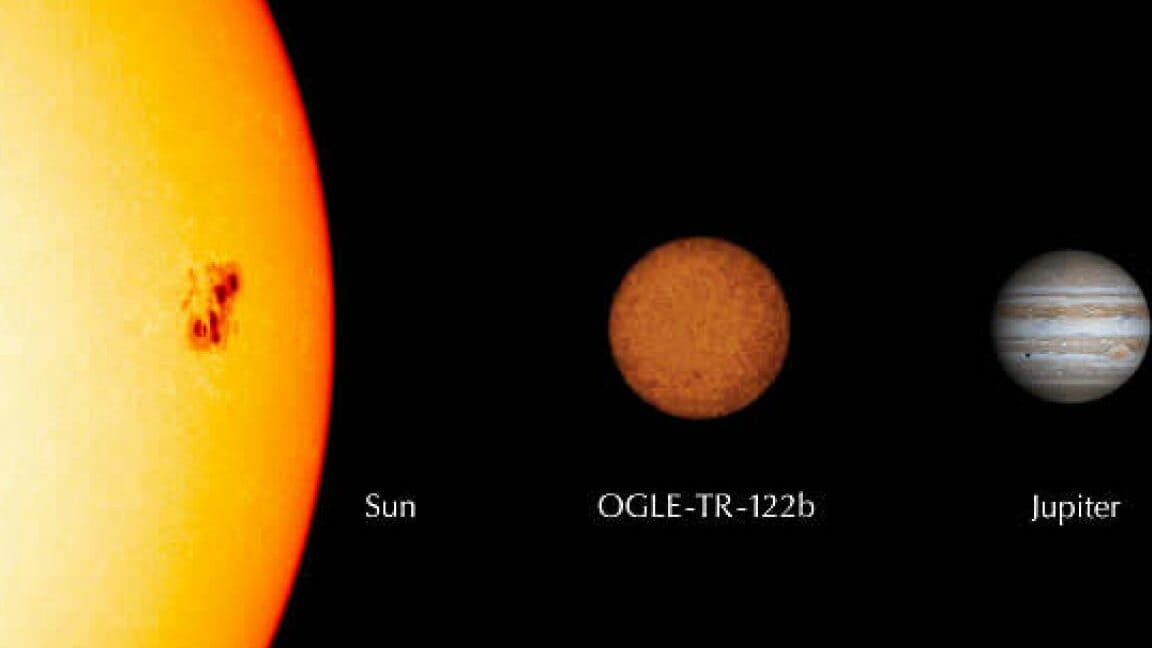Even though the Sun appears enormous to us, it is actually considered average among the vast number of stars in the universe. There are stars that are much larger, as well as stars that are incredibly small. However, let’s take a closer look at the sizes of stars.
The smallest stars in the cosmos are known as red dwarfs. They have about half the mass of the Sun, but can also be found with a mass as low as 7.5%. This is the minimum mass required for nuclear fusion to occur. If the mass is even lower, we end up with brown dwarfs. The diagram below provides a detailed comparison of the sizes of the planets in our Solar System with the Sun and other large stars such as Sirius, Arcturus, Aldebaran, Betelgeuse, and Mu Cepheus.
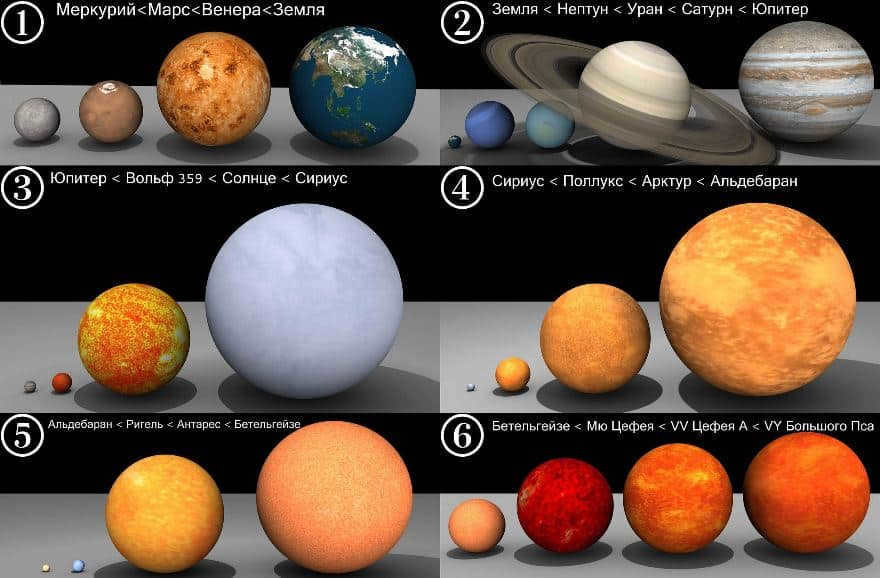
Comparative size of various stars and planets
When considering red dwarfs, it is important to mention Proxima Centauri, which is the closest to us. Proxima Centauri has 12% of the mass of our Sun and is about 14% the size of our Sun (slightly larger than Jupiter).
Currently, our Sun has a diameter of 1.4 million kilometers. However, when it reaches the end of its life, it will expand and become a red giant, growing 300 times in size and consuming the nearby planets. An even larger star is Rigel, a blue supergiant, which is 17 times the mass of our Sun and produces 66,000 times more energy. Rigel is also 62 times larger than our Sun.
Looking for a larger star size? No problem! How about considering the red supergiant Betelgeuse, which has a mass 20 times greater than that of our Sun and is currently nearing the end of its life cycle. Scientists believe that there’s a possibility of this star exploding as a supernova within the next millennium.
But wait, there’s more! The largest star known to us is VY Canis Majoris, located in the constellation Canis Major. This red supergiant is a staggering 1,800 times bigger than our Sun. If we were to replace our Sun with VY Canis Majoris, it would easily extend all the way to Saturn’s orbit.
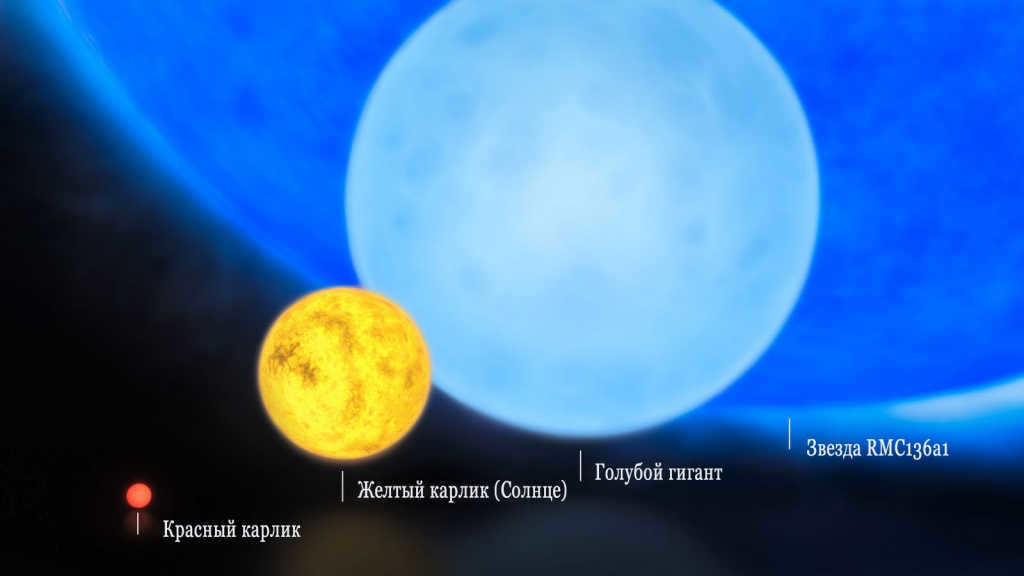
Stars are the primary sources of light in the Universe. In addition, the Sun, which is the nearest star to us, serves as the main energy source for life on Earth. We all understand the insignificance of our small blue planet when compared to the powerful Sun. However, it is truly astonishing to contemplate the ratio of the volumes of these two celestial bodies. Consider this: the Sun is more than a million times larger than the Earth! Stars are some of the largest single-phase objects in space, but just how much can their sizes vary?
Misleading spots in the atmosphere

Is it a star or something else?
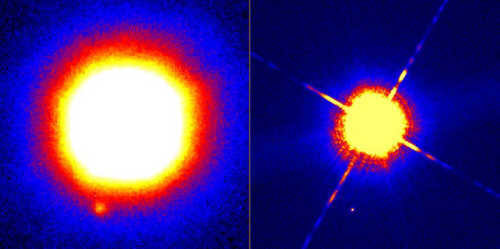
There is ongoing discussion about whether obscure objects like brown dwarfs should be classified as stars or not. Currently, they are recognized as hydrogen sub-stars with sizes ranging from 0.012 to 0.0767 solar masses. These sizes are comparable to that of Jupiter. Brown dwarfs contain thermonuclear processes, similar to stars. However, the release of heat primarily comes from fusion reactions of isotopes of light nuclei such as lithium, beryllium, boron, and deuterium. The contribution of classical proton fusion to the total heat release is minimal. Brown dwarfs are believed to make up a significant portion of the stars in the universe. Some astronomers speculate that brown dwarfs may also account for a considerable amount of dark matter. Now, let us continue!
Starting from the tiniest

The dimensions of the stars within the Milky Way
Let us ponder, what are the measurements of the tiniest constituents of this particular type of celestial entities? We instruct the computer system on board to navigate towards the closest neutron star, and behold, we are nearing a minuscule star with an unusual designation – RX J1856.5-3754.
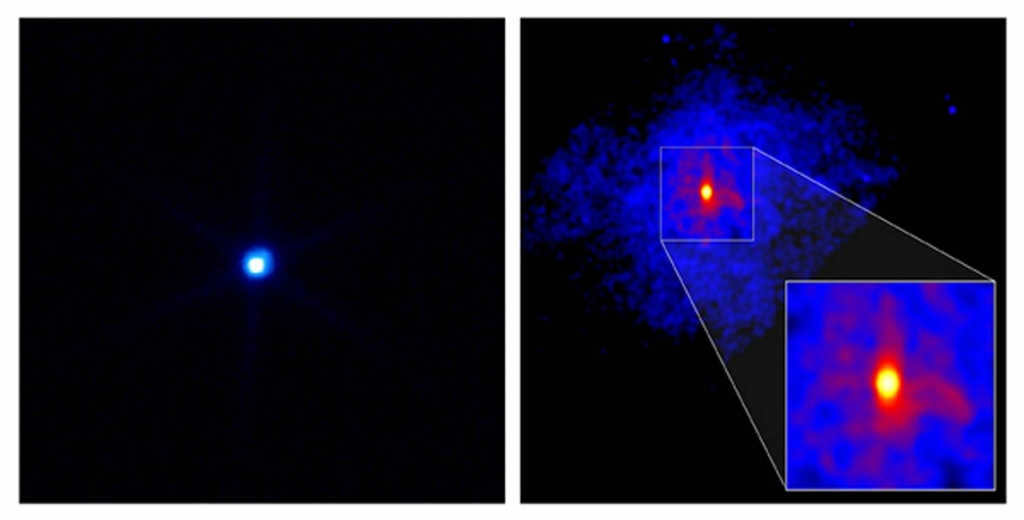
RX J1856.5-3754 is portrayed in an X-ray image captured by the Chandra telescope.
Exploring Neutron Stars
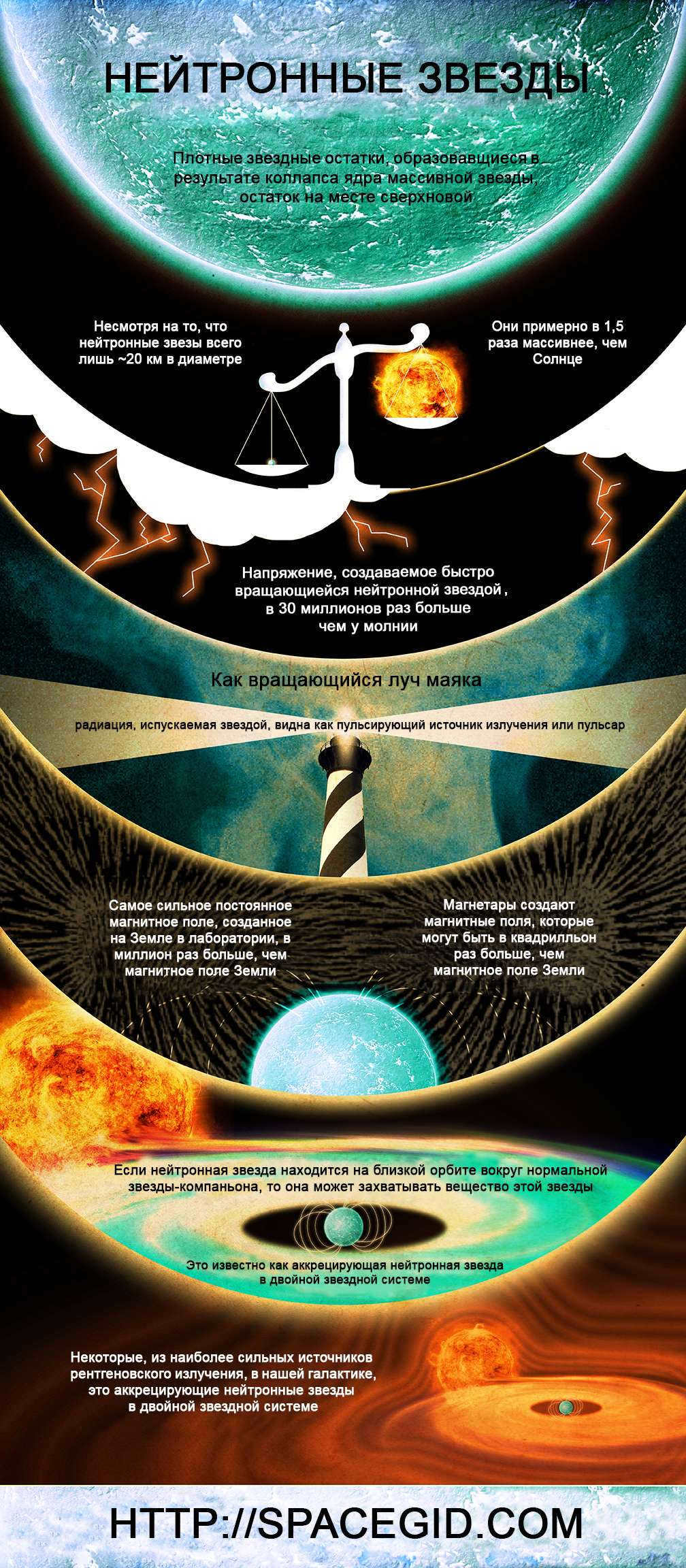

Neutron stars captured in a single image
We muster the courage to descend further in order to obtain a more detailed view of the celestial body, however, the cabin alarm abruptly starts blaring, cautioning us about the immense magnetic field.
Additional resources
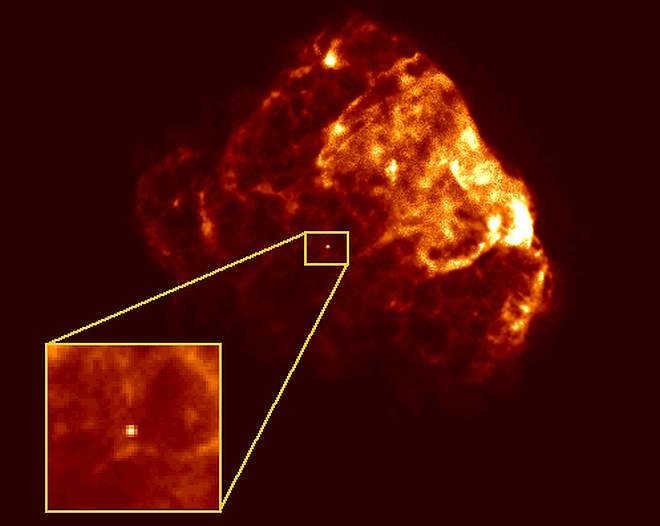
Van Maanen’s Star
can be rephrased as
Van Maanen’s Star: An Overview
.
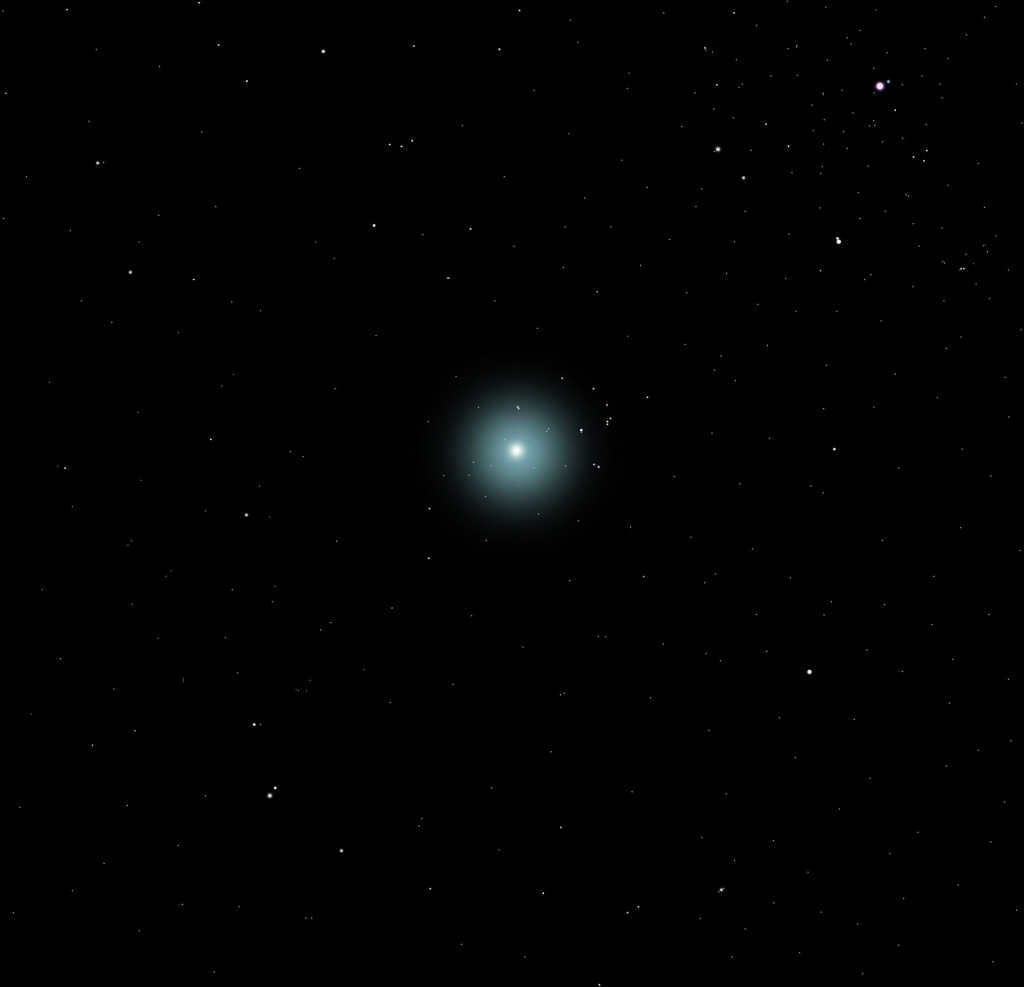
In the vast expanse of the cosmos, a diminutive crimson star emits a gentle glow. These stars possess a size and mass that is only a fraction of that of our Sun, and their radiance pales in comparison, being thousands of times fainter.
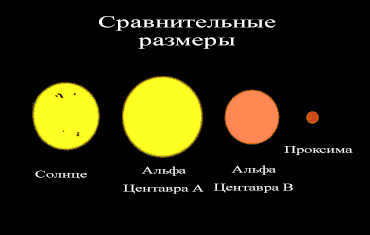
It is highly probable that this modest star will outlast the Sun by a significant margin, and if humanity seeks a celestial body that can provide refuge after the demise of our own star, it will not need to venture too far. In terms of astronomical distances, naturally.
Betelgeuse.
The red supergiant star in the constellation Orion.
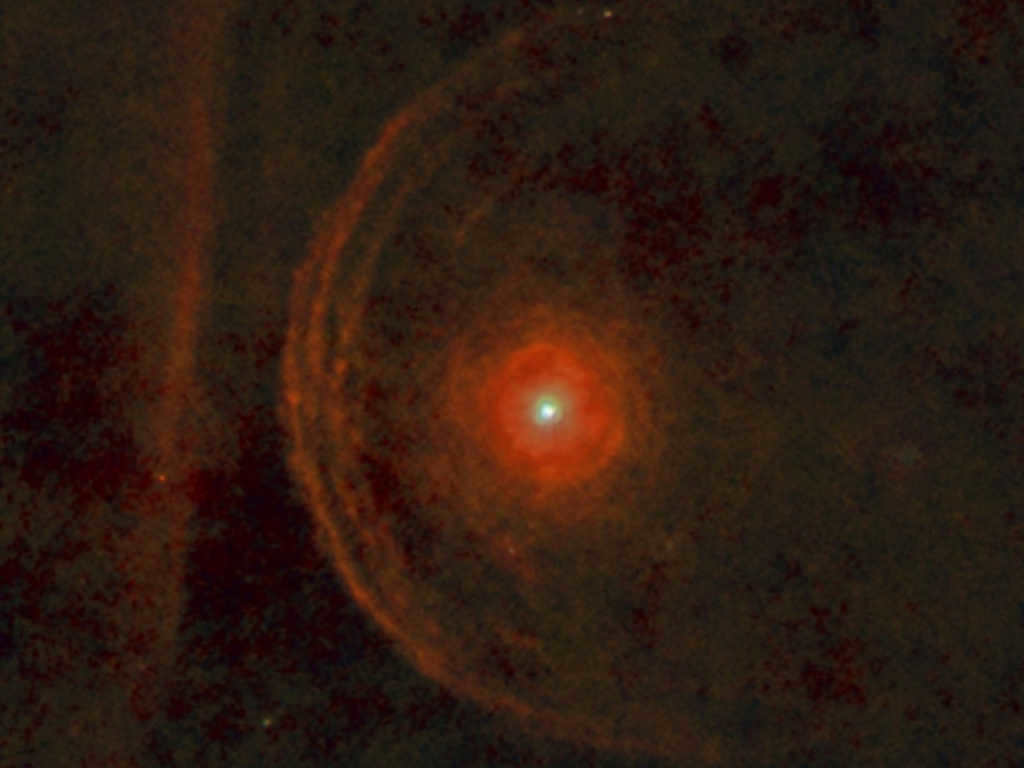
Alnitak
Alnitak is the easternmost star in the Orion’s Belt constellation. It is a massive and bright star, classified as a multiple star system. Alnitak is part of a triple star system, with two smaller companion stars orbiting around it. It is located approximately 800 light-years away from Earth and has a luminosity about 100,000 times greater than that of the Sun. Alnitak is a hot blue supergiant star, with a surface temperature of around 30,000 degrees Celsius. It is also known by its Bayer designation Zeta Orionis.
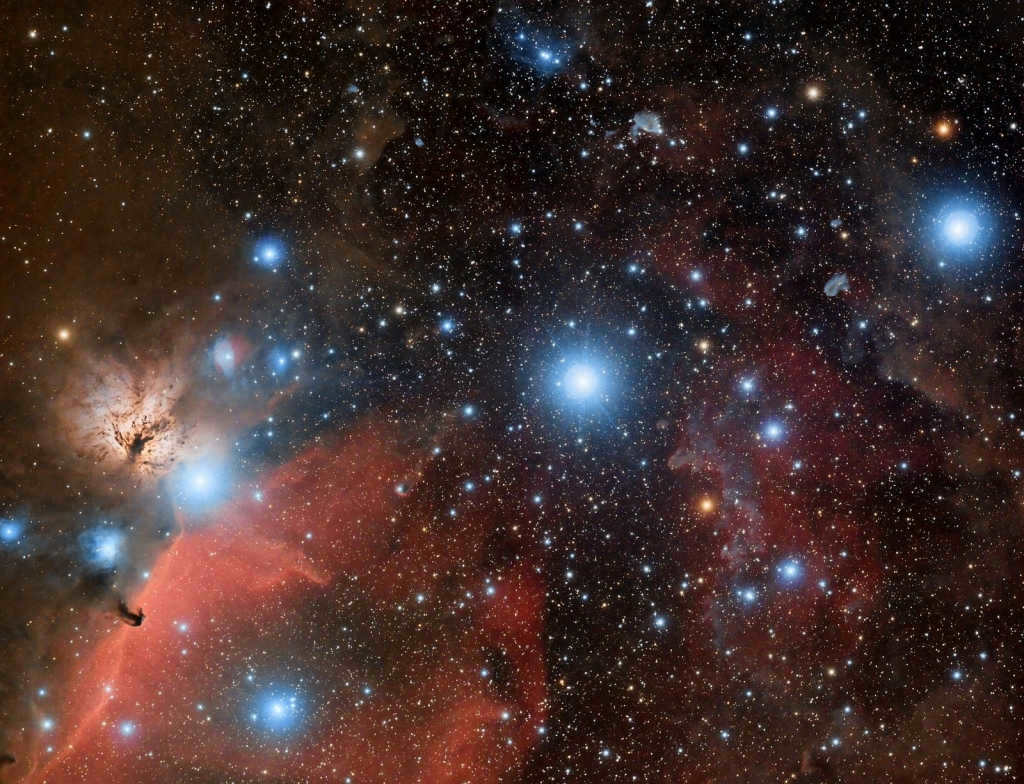
Alnitak, Alnilam and Mintaka are three stars in Orion’s Belt. They are commonly referred to as the “Three Kings” or the “Three Sisters”. These stars are among the most well-known and easily recognizable in the night sky. They are located in the constellation of Orion, which is one of the most prominent and easily identifiable constellations. The stars are named after the Arabic names for their respective positions in the belt. Alnitak is the easternmost star, Alnilam is the center star, and Mintaka is the westernmost star. Together, they form a straight line that is easily visible to the naked eye.
Antares
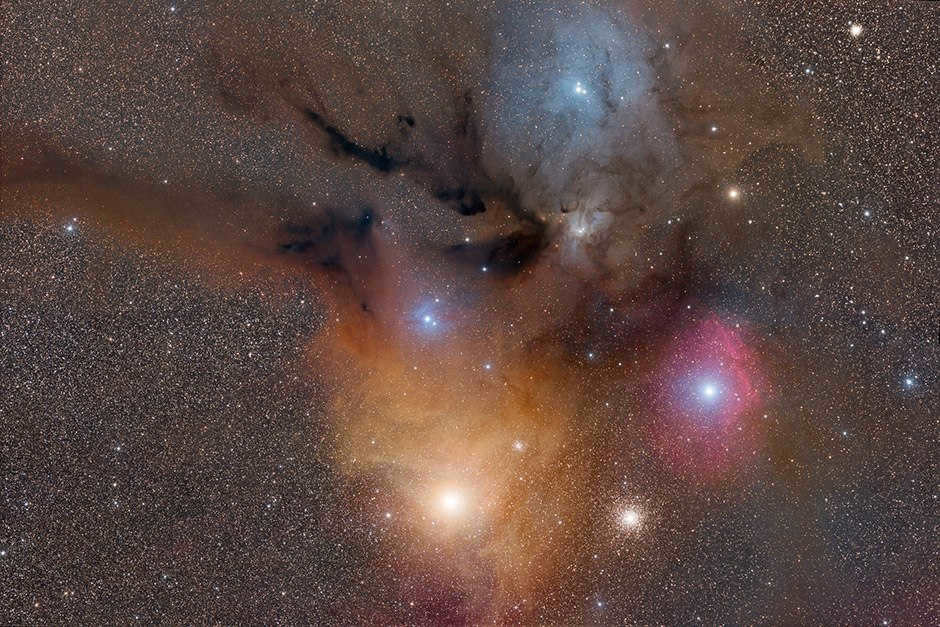
A nebula is located near Antares and Rho of the Serpentarium.
The UY nebula is located near the Shield.
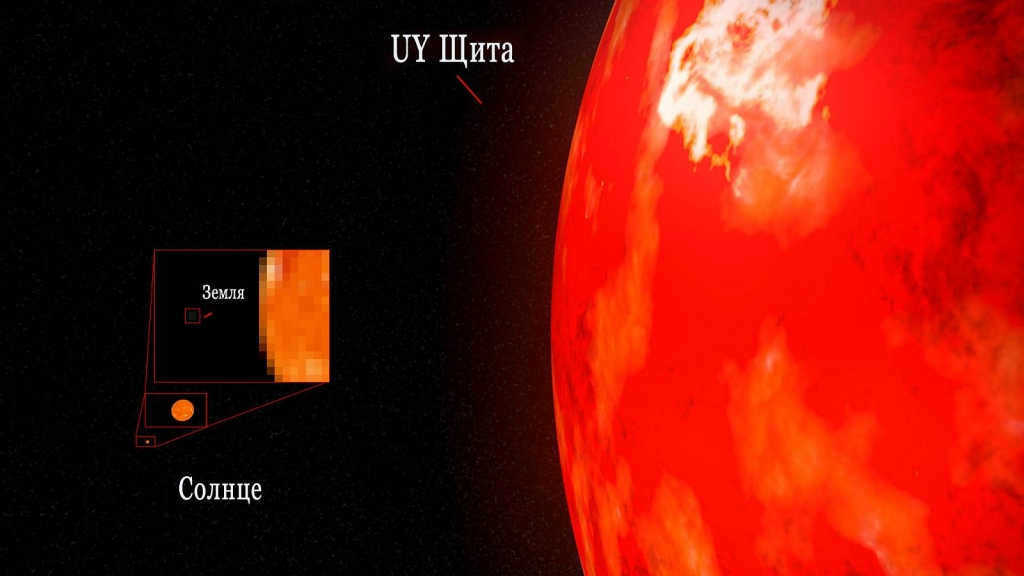

Comparison of UY of Shields to the Sun.
What is the main conclusion?
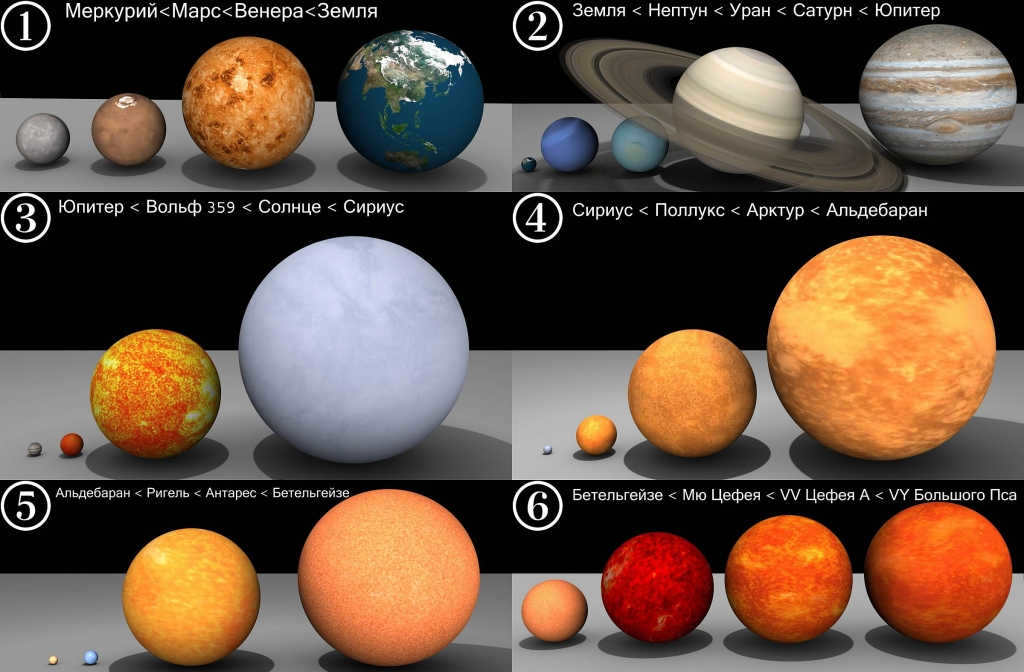
In summary, it is important to acknowledge that stars can differ significantly in both mass and physical dimensions. Some stars possess incredibly high densities, while others are extremely rarefied. Stars exhibit a wide range of luminosities, colors, temperatures, and lifetimes. The size of a star is influenced by the combined forces of gravity, which attempts to compress the star, and the pressure exerted by the heated gas within it. Currently, the theory of stellar evolution remains incomplete.
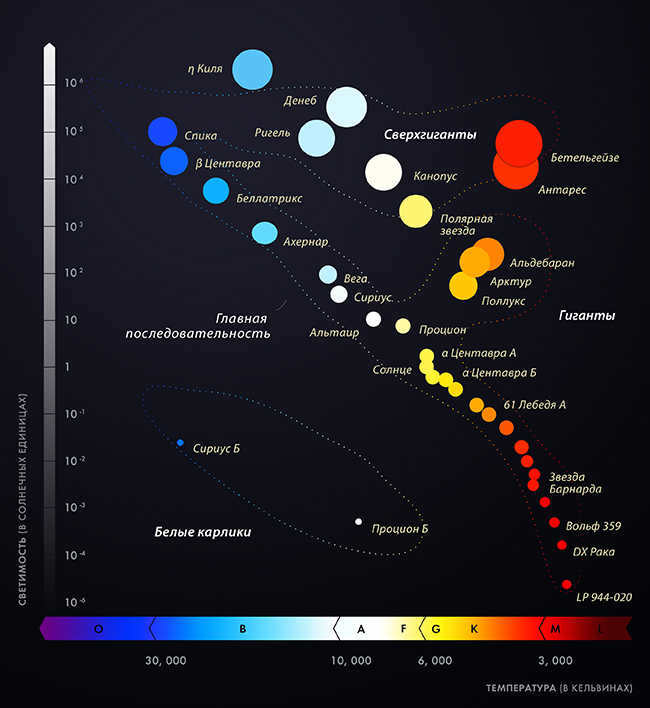
The Hertzsprung-Russell diagram is a graphical representation of the relationship between the luminosity and temperature of stars. It is a tool used by astronomers to classify and understand the life cycle of stars.
Resources related to the Hertzsprung-Russell diagram
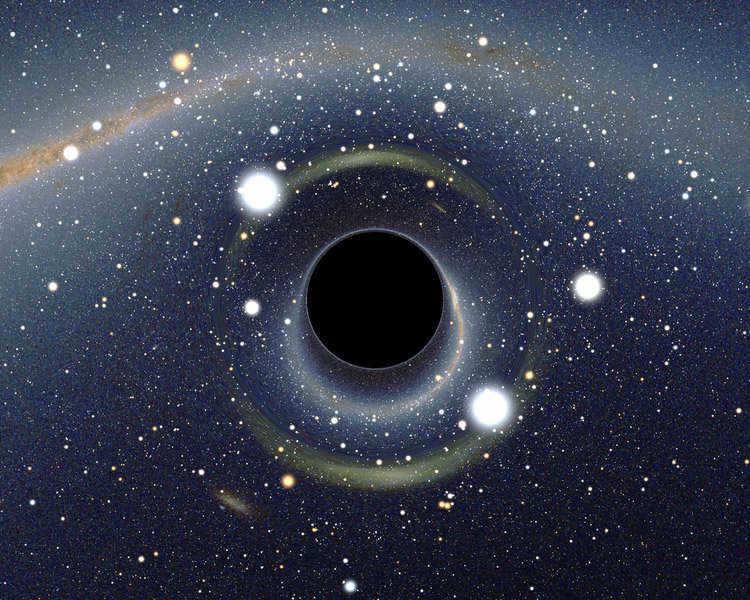
Naturally, there are inherent limitations preventing the existence of a star the size of a galaxy. Stars with masses ranging from 8 to approximately 150 times that of our sun live fast and die young, as the temperature within their core is immensely high and nuclear reactions occur at a rapid pace. Until recently, it was believed that the upper mass limit for a star was 150 times that of our sun. However, recent advancements in space exploration have indicated that 300 solar masses may not be the maximum mass limit for a star! In these colossal stars, aside from the incredibly fast fusion reactions, there are additional fluctuations caused by the interaction of particle-antiparticle pairs. These supergiants can even undergo annihilation and explode before experiencing the traditional collapse. However, all of this remains solely theoretical.
Indeed, celestial objects vary in a multitude of features. One primary differentiating factor among stars lies in their dimensions, weight, and composition.
Classifying stars based on size
In the vast expanse of the universe, stars exhibit diverse sizes, ranging from small and medium to large and extra-large or colossal.
Nevertheless, the field of astronomy does not categorize these entities solely based on size. Instead, they are classified according to shared characteristics, with nearly all parameters and properties being interdependent.
Stars classified by their size
In reality, stars can be categorized by their size into the following groups:
Additionally, there are hypergiants, which are the brightest and most massive stars. However, these stars are extremely rare in the universe and have relatively short lifespans, resulting in their scarcity.
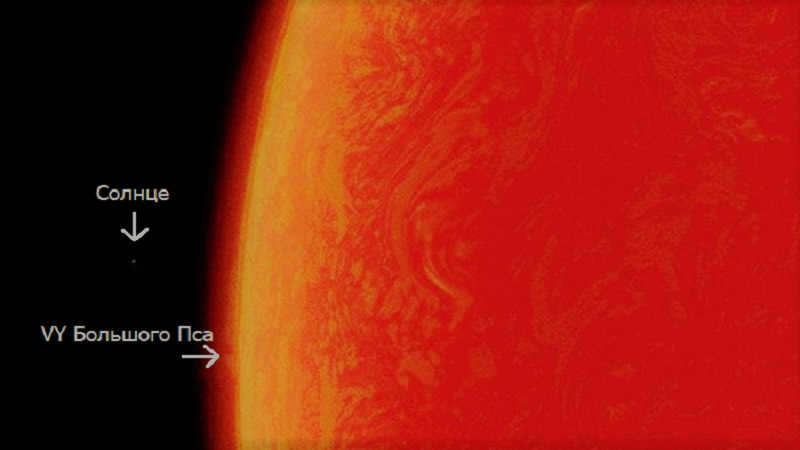
The VY red hypergiant belonging to the constellation Canis Major.
How to measure the magnitude of a star
There are three methods for determining the magnitude of stars:
- Observation. When a star is eclipsed by the Moon, its angular size can be determined. If the distance to the star is known, its magnitude can be calculated.
- Using an optical interferometer, a specialized measuring device that allows for the measurement of an object’s boundaries (distance is not a factor).
- Theoretically, using the luminosity formula. If the luminosity and temperature of a star are known, its radius can be calculated.
What is the relationship between the sizes of stars and their luminosities?
The connection between the sizes of stars and their luminosities can be determined by using the formula to calculate the luminosity of a stellar body:

The luminosity formula shown above is directly related to the star’s radius.
It appears that these two parameters are interconnected and dependent on each other.
Understanding the true sizes of celestial objects can be challenging for us humans. After all, they can range from thousands to millions of thousands of kilometers.
Our main point of reference is the Sun, which is over a million times larger than our planet. Therefore, comparing star sizes to the Earth’s size is not only difficult but also irrelevant.
To simplify the determination of the radius (size) of stellar bodies, astronomers often use a unit of measurement equal to the equatorial radius of the Sun, which is 696,392 km.
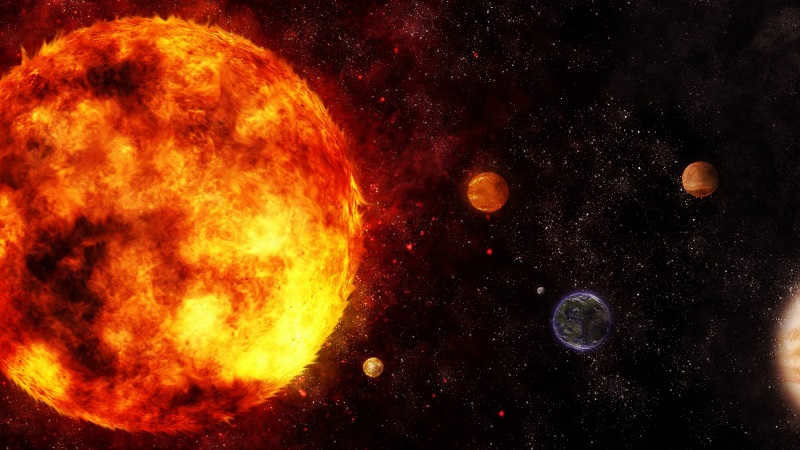
The Sun in the Solar System
What is the size of the smallest stars?
Small stars, known as red dwarfs, have relatively small volumes and masses. Specifically, most red dwarfs have a mass equal to half of our Sun’s mass, and their radius is quite small.
In addition, there are white dwarfs, which have a size comparable to that of Earth. However, their density is much greater than that of Earth, by almost a million times.
Finally, the smallest stars are neutron stars, which are a hundred million times smaller than our planet! However, in terms of mass and density, they surpass Earth.
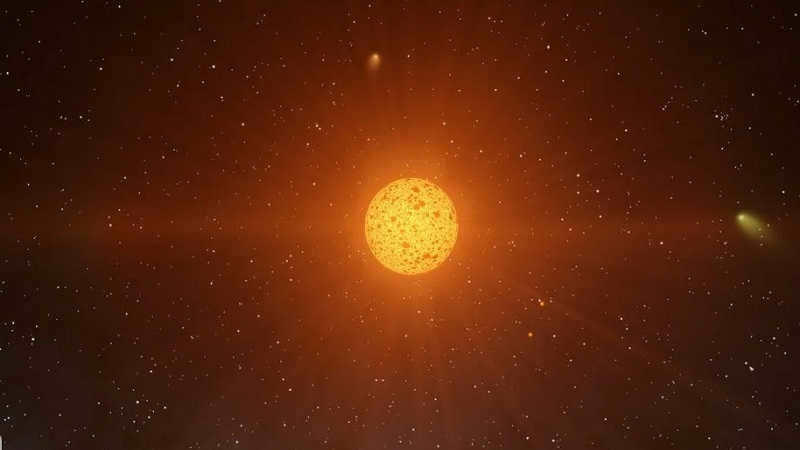
Proxima Centauri, one of the smallest stars in our Universe.
The vastness of our Universe is unquestionably filled with an incredible array of celestial wonders. It is a truly beautiful and awe-inspiring sight!
Among these wonders are the stars, which are fascinating creations of the cosmos. They are among the most prominent entities in outer space.

In our previous physics class, we learned that the Sun is an average star among the vast number of stars in the Milky Way galaxy. How do other stars compare to our Sun? What sets them apart? Which physical and chemical factors are essential in determining a star’s nature? Let’s take a brief look at the fundamental properties of stars, including their dimensions, mass, and composition.
Dimensions and Weight of Stars
When we observe the stars closest to Earth, we can clearly see that their dimensions differ. Unfortunately, the vast majority of stars are located at such a great distance that it is impossible to perceive their angular dimensions. As a result, the key characteristics of stars are determined through indirect means.
Nevertheless, calculations indicate that the smallest stars, known as white dwarfs, have a diameter of approximately one thousand kilometers, while the largest stars, known as red giants, have a diameter of one billion kilometers (which is equivalent to the diameter of Jupiter’s orbit).
Furthermore, there are stellar remnants such as neutron stars and black holes, which have dimensions ranging from a few kilometers to tens of kilometers. However, these remnants do not emit any light.
The masses of stars are also primarily estimated using indirect methods. The only way to directly estimate the mass of a star is if it is part of a binary system, as the masses are dependent on the parameters of their respective orbits.
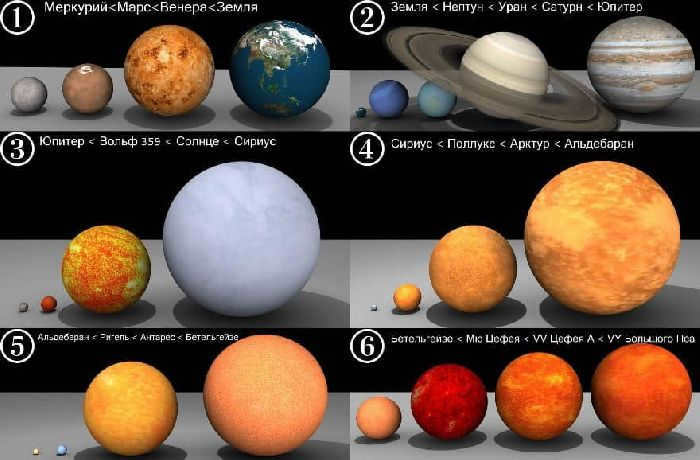

Figure 1. Comparison of star sizes.
Chemical makeup of stars
Hydrogen is the most abundant element in the universe, accounting for over 90% of all atoms. Stars are massive spheres of hydrogen, where hydrogen is converted into helium in their cores. Helium atoms make up about 8% of the universe’s atoms.
In the cores of the most massive stars, helium undergoes fusion to form lithium, carbon, and eventually iron. However, these elements combined make up less than 1% of the universe’s atoms.
Thermonuclear reactions that produce atoms heavier than iron require the absorption of energy, making them unable to be the primary source of energy for stars. Additionally, atoms heavier than iron are formed in very small quantities.
Figure 2. Stellar nucleosynthesis
Spectral classification of stars
Spectral analysis is the most informative method for determining the composition and temperature of stars. Each chemical element has its own unique spectrum. Therefore, by analyzing the spectrum of a star, we can accurately determine its chemical composition.
Based on the distinct features of the spectra, stars are classified into various classes, represented by letters of the Latin alphabet. The primary factor influencing the spectrum is the temperature of the stars, so the spectral classes are primarily categorized based on temperature. The class letter is typically followed by a subclass number (0 to 9). The final component of the class is a Roman numeral (from I to VII) indicating the size of the star (ranging from giant to dwarf).
The Sun is classified as a G2V star, which means it is a yellow dwarf with a temperature of approximately 5200 K.
Other stellar classifications are based on the star’s composition, such as class S for stars with higher levels of elements like zirconium, titanium, yttrium, or technetium. Spectral features in stars are often denoted by lowercase letters. The following table provides an overview of the main spectral classes:
Figure 3. The Spectral Classification of Stars
Key Takeaways
Stars come in a range of sizes, from thousands to billions of kilometers in diameter, and have masses that can vary from a fraction to hundreds of times that of the Sun. Chemically, stars are primarily composed of hydrogen, which undergoes fusion to form helium in their cores. There are also trace amounts of other elements present. The temperature and composition of a star are reflected in its spectrum, leading to the classification of stars into spectral classes.
When observing stars, we see them as points of light with varying brightness. Some stars display distinct colors, such as the red hue of Betelgeuse or the orange tint of Aldebaran. However, we cannot determine the size of a star just by looking at it, as they all appear the same, even through the most powerful telescopes.
However, it is fascinating to understand the dimensions of stars, ranging from the tiniest to the most enormous. This, of course, refers to the stars known to scientists, as the Universe is vast and perpetually conceals astonishing phenomena that remain undiscovered.
Therefore, let us proceed systematically and explore the various sizes of stars.
In order to gain a deeper understanding of the subject at hand, it is beneficial to initially examine the widely known Hertzsprung-Russell diagram. Within this diagram, researchers have sorted recognized stars based on their temperature and luminosity.
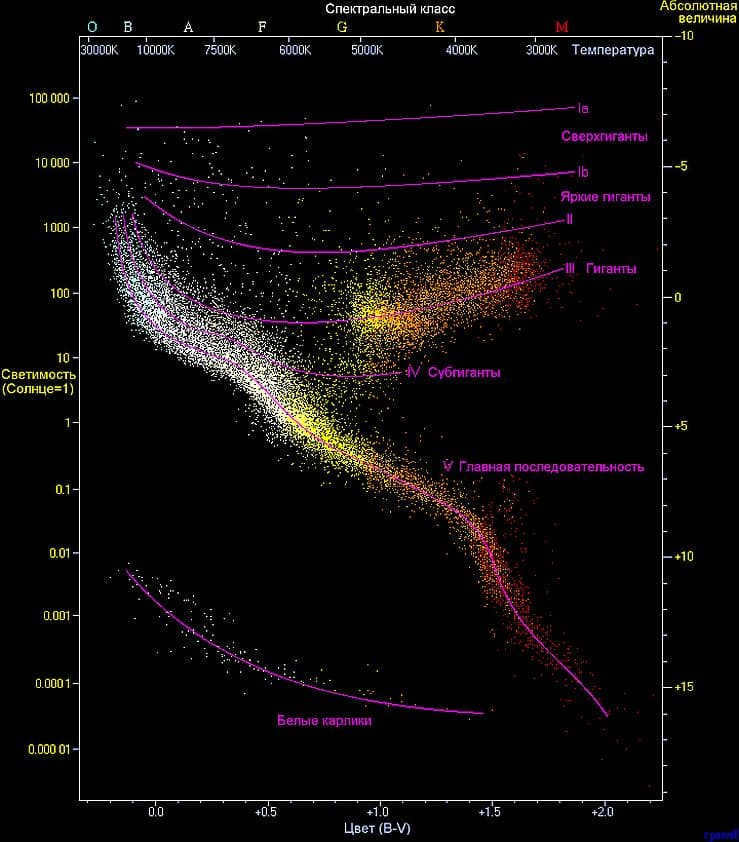
It was discovered that the stars have segregated into distinct clusters, and within these clusters, the variation in size is evident. Consequently, white dwarfs exist in isolation, whereas giants and supergiants have formed their own distinct clusters.
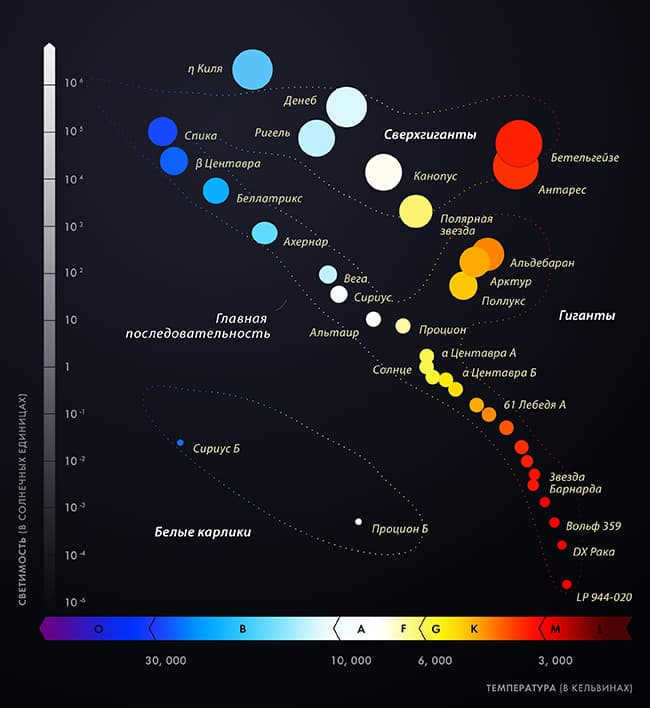
This diagram displays a selection of stars.
Furthermore, an intriguing category of stars known as neutron stars exists, and their size is truly remarkable.
Undoubtedly, our primary focus should be directed towards the Sun. After all, it happens to be the nearest star to us and is extensively researched and measured. Furthermore, all other stars are typically compared to the Sun in terms of size and mass, making it a sort of benchmark.
Hence, the Sun can be classified as a typical yellow dwarf, similar to the numerous ones present in our Milky Way galaxy. In the sky, we perceive it to be the same size as the Moon, but in reality, it is substantially larger. Its equatorial diameter measures approximately 1,392,700 kilometers, with the radius being half of that – nearly 700,000 kilometers.
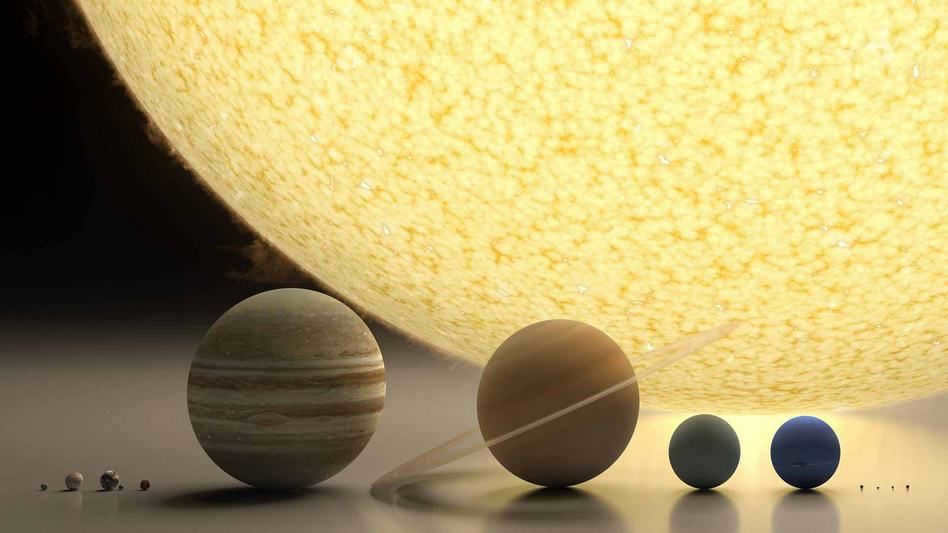
The magnitude of the Sun in comparison to the planets within the Solar System.
It is worth noting that stars possess significant mass and rotate at high speeds, resulting in a slight flattening between the polar regions. Consequently, the equatorial radius of a star is always marginally larger than that of the poles.
What is intriguing is that if we were to place planets like Earth along the diameter of the Sun, we would be able to fit 109 planets consecutively. Furthermore, if we were to stack them inward, a staggering number of 1,301,019 planets could be accommodated within the Sun.
Now you can truly grasp the immense size of the Sun, despite it being classified as a yellow dwarf and therefore not particularly remarkable – an entirely average and ordinary star. However, the dimensions of other stars are even more fascinating to contemplate!
Brown dwarfs and their dimensions
It appears that the tiniest stars are those that barely have enough mass to sustain a thermonuclear reaction. These objects are known as brown dwarfs. With a mass ranging from 13 to 75 times that of Jupiter, they are roughly the same size as Jupiter itself, measuring only about 15 thousand kilometers in radius.
If a brown dwarf had a mass below 13 times that of Jupiter, it would not be able to sustain any thermonuclear reaction and would be classified as a planet. On the other hand, if its mass exceeded 75 times that of Jupiter, it would be considered a fully-fledged star.
In practice, objects of this class occupy a position intermediate between stars and planets. While they do undergo thermonuclear reactions, their power output is relatively low, causing them to gradually contract and cease emitting light. They possess a limited supply of hydrogen, which can sustain them for only a few million years. Their surface temperatures are not very high, ranging from only 1 to 2 thousand degrees, and they primarily emit infrared radiation. It is possible for some brown dwarfs to possess their own planets.
Is a star the size of Jupiter the smallest possible? No, there are even smaller ones.
A neutron star is an incredible object that has the mass of the Sun but a diameter of only 10 to 20 kilometers. Essentially, these stars are the superdense cores of giant stars.
Due to their massive size, the substance within a neutron star has an astonishing density that is several times greater than an atomic nucleus. In fact, just a teaspoon of neutron star matter would weigh a billion tons! However, the inner core of a neutron star is even denser. Within this core, there are unique processes occurring that differ from those found in ordinary stars. The surface gravity and magnetic field strength of neutron stars are immense, as the enormous mass is concentrated within a small volume.
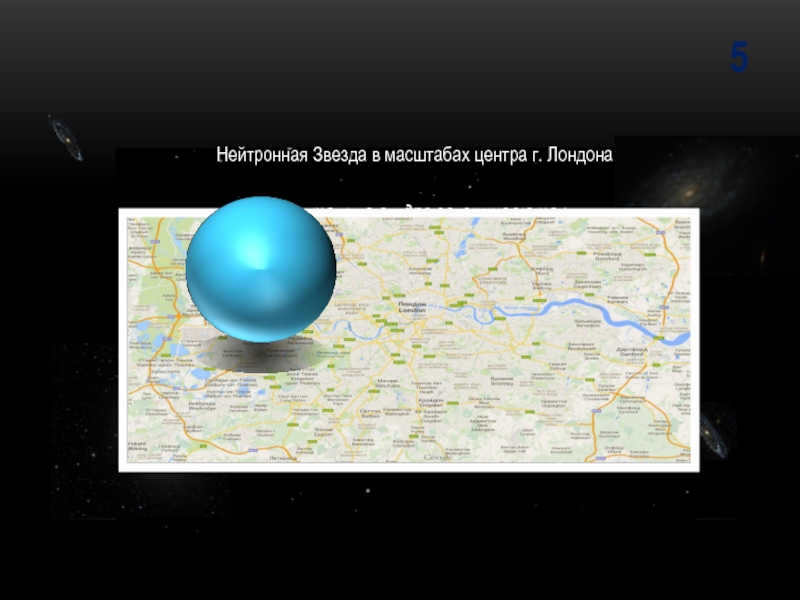
The dimensions of a neutron star are merely a few dozen kilometers.
In spite of their diminutive size, neutron stars possess high temperatures ranging from 100,000 to a million degrees on their surface. Additionally, they rotate at an incredibly fast rate, with some completing several hundred revolutions per second. They emit focused and intense radio waves in various frequency ranges, including X-rays. If a neutron star is aligned with our line of sight, it is identified as a pulsar. Pulsars are essentially rapidly rotating neutron stars that emit radiation in our direction.
The dimensions of white dwarfs
After a red giant sheds its outer layers, all that remains is its core, which undergoes a process of contraction and becomes extremely hot. This compact star, known as a white dwarf, is incredibly small in size, with a mass that can be slightly greater or slightly less than that of the Sun.
There are similarities between white dwarfs and neutron stars in terms of their mass, but neutron stars are even smaller in size. However, white dwarfs have a lower density, although they are still relatively massive – a cubic centimeter of white dwarf matter can weigh tens of tons.
White dwarfs are subject to the Chandrasekhar limit, which dictates that if their mass at formation exceeds 1.4 times the mass of the Sun, they will collapse and transform into neutron stars. If their mass is below this limit, they will remain as white dwarfs.
Typically, white dwarfs are roughly 100 times tinier than the Sun. In other words, an average star of this variety has a radius of about 14 thousand kilometers. Some white dwarfs can be as small as planet Earth, like Sirius B.
In the distant future, our Sun will also transform into a white dwarf.
Red dwarfs are complete stars. They possess approximately three times the mass of the Sun and a surface temperature of roughly 3500 degrees Celsius. In other words, they are relatively cooler in comparison to other stars and emit predominantly red light. This is the reason behind their name.
Comparison of sizes between red and brown dwarfs.
A red dwarf is significantly smaller than a solar dwarf. The smallest known red dwarfs have a radius that is only 11% and a mass that is only 8% of the sun’s. This means that the radius of such a red dwarf is approximately 150,000 kilometers. While this may seem substantial to us, it is actually quite small in comparison to other stars. For example, a red dwarf is dwarfed by a neutron star, which can have a radius of 10 to 20 kilometers. Even a white dwarf, which is ten times smaller than a red dwarf, is still larger in size.
We have discussed the smallest stars, but what about the larger ones?
What is the size of the biggest stars?
When we look at the Hertzsprung-Russell diagram, we can observe that the largest stars are located in the upper right-hand side. These stars are known as hypergiants and they truly are colossal in the stellar world. A typical hypergiant can weigh anywhere from 100 to 120 times more than the Sun and can be thousands of times larger in size.
Previously, the UY Shield star held the title for being the largest hypergiant. At its maximum expansion, it reaches a size that is 1900 times larger than the Sun. However, it is important to note that this star pulsates, so its size can vary. To put its immense size into perspective, this monstrous star could easily accommodate 5 billion stars like the Sun within its volume, and its diameter measures a mind-boggling 2.4 billion kilometers.

Stevenson 2-18 is of immense size when compared to the Sun.
However, currently the most prominent star is Stevenson 2-18, a red hypergiant that surpasses even Shields’ UY in magnitude. This star is located in the same constellation and is 2158 times larger than the Sun, spanning a distance of 3 billion kilometers! To put it in perspective, this is equivalent to 10 astronomical units, which is ten times the distance between Earth and the Sun. If this colossal star were to replace the Sun, its surface would extend just beyond the orbit of Saturn. Due to its vast surface area, this star emits radiation equivalent to 440,000 suns.
So, what are the various sizes of stars?
Let’s summarize the findings. Here’s the breakdown:
- Neutron stars and white dwarfs are the smallest, ranging from 10 kilometers in diameter to the size of planet Earth.
- On the other hand, hypergiants take the crown for the largest stars. The biggest one we know of has a diameter of 3 billion kilometers.
That’s an immense range, spanning from just a few kilometers to billions. And within this vast spectrum, there exists a multitude of stars with their own distinct characteristics. Each star is truly one-of-a-kind and worth exploring.
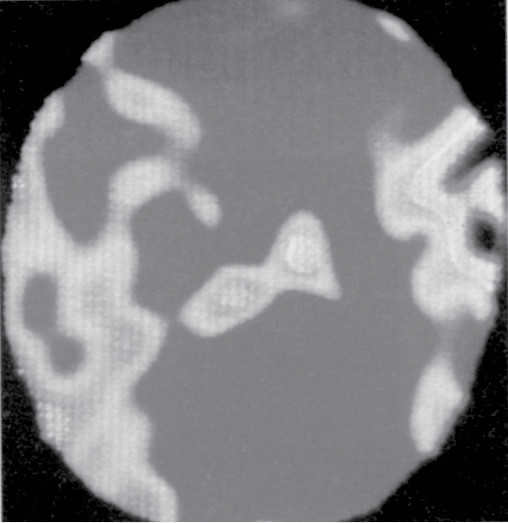
Regrettably, stars are positioned at such vast distances from us that, with only a few exceptions, they appear as mere points of light even when observed through the most advanced telescopes. It is only in recent times that it has become possible to capture images of some of the largest stars, revealing them as disk-like structures with observable spots (Fig. 5.19).
In the majority of cases, the sizes of stars must be deduced by analyzing data on their luminosity and temperature. The luminosity of a star can be determined using the same formula employed for calculating the luminosity of the Sun:
L = 4πR 2 σT 4 .
The ratio of the star’s luminosity to that of the Sun can be expressed as:
If we assume that R☉ = 1 and L☉ = 1, we can derive an equation for calculating the star’s radius (in terms of solar radii):
The calculations performed are in good agreement with the interferometer’s direct measurements of the sizes of the largest stars, which are located at close distances.
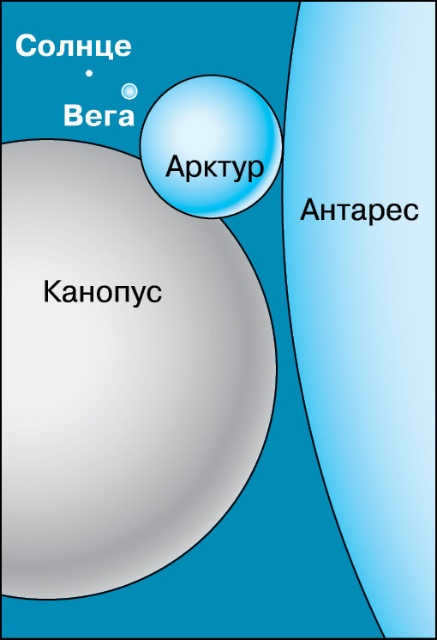
Figure 5.20 showcases the size of the Sun when compared to massive giants and supergiants in the universe.

Fig. 5.21. Dimensions of dwarf stars
The size of dwarf stars varies greatly depending on their type. While the red supergiants Antares and Betelgeuse are hundreds of times larger than the Sun in diameter (Fig. 5.20), the red dwarfs belonging to the main sequence have a diameter several times smaller than that of the Sun. The smallest stars, known as white dwarfs, have a diameter of only a few thousand kilometers (Fig. 5.21).
When it comes to density, the average density of stars can differ significantly from that of the Sun. Some supergiants have an average density as low as 10 -3 kg/m 3 , which is 1000 times less than the density of air under normal conditions. On the other hand, white dwarfs have an incredibly high density of about 10 9 kg/m 3 .
Stars have a variety of internal structures depending on their mass and size, but they all share a similar chemical composition. The majority of their mass, around 95-98%, consists of hydrogen and helium.

Figure 5.22: Internal structure of stars belonging to different categories
In order to comprehend the interconnections, origin and evolution of various types of stars, extensive research on the complete set of stars forming gigantic stellar systems, known as galaxies, was necessary. galaxies.
1. The double star has an orbital period of 100 years. The major semi-major axis of the visible orbit a = 2.0ʺ, and the parallax p = 0,05ʺ. Calculate the total mass and the individual masses of the stars if their distances from the center of mass are related as 1 : 4.
Given that A1 : A2 = m2 : m1, then m1 = 4m2.
A 3 : T 2 or 4m2 + m2 = A 3 : T 2 , meaning that m1 + m2 = A 3 : T 2 or 5m2 = A 3 : T 2 .
Response: The masses of the objects are m1 = 5.12 solar masses and m2 = 1.28 solar masses.
2. If the luminosity of Arcturus is 100 and the temperature is 4500 K, Arcturus is larger than the Sun by a certain factor.
The radius of Arcturus is 18 times larger than the radius of the Sun.

QUERIES 1. What is the reason for the difference in brightness of certain binary stars? 2. How do the sizes and densities of supergiant and dwarf stars compare? 3. What are the dimensions of the tiniest stars?

REPHRASED EXERCISE 19 1. Calculate the total mass of the binary star Capella given that its orbit has a major semi-axis of 0.85 astronomical units and an orbital period of 0.285 years. 2. How much more luminous is Rigel compared to the Sun, considering its parallax is 0.003 arcseconds and its apparent magnitude is 0.34? 3. Determine the average density of a red supergiant with a diameter 300 times larger than that of the Sun and a mass 30 times greater.
§ 24.VARIABLE AND NONSTATIONARY STARS
Aside from studying double stars, the exploration of variable stars has played a significant role in shaping our understanding of the physical properties of stars. In the case of variable stars, unlike eclipsing variables, these stars undergo changes in luminosity due to various processes occurring within the star itself. Presently, there are numerous types of variable stars known, numbering in the tens of thousands. While some exhibit strictly periodic changes in luminosity, others often deviate from periodicity or display less strict periodicity. Additionally, there are those variable stars whose luminosity changes in an irregular manner, and as of yet, no definitive patterns have been identified in these fluctuations.

Figure 5.19: Spots on the surface of Betelgeuse
Regrettably, the stars are situated at such a vast distance from us that, with a few exceptions, they appear as mere points even when observed through the most powerful telescopes. Only in recent times, for a select few of the largest stars, has it become possible to capture an image resembling a disk, complete with spots (Fig. 5.19).
In the majority of cases, the sizes of stars have to be estimated based on data regarding their luminosity and temperature. The luminosity of a star is calculated using the same formula as that used for the Sun:
L = 4πR 2 σT 4 .
The ratio of the luminosities of the star and the Sun will be equal:
Assuming that R☉ = 1 and L☉ = 1, we can derive an expression for calculating the radius of the star (in solar radii):
The calculations yield results that are in good agreement with the measurements obtained using an interferometer to determine the sizes of the largest stars, which are relatively close in distance.

Fig. 5.20. Comparing the Sun to giants and supergiants

Figure 5.21 showcases the dimensions of dwarf stars
It has been discovered that the stars with the highest luminosity, known as supergiants, are indeed very large. For instance, the red supergiants Antares and Betelgeuse have diameters that are hundreds of times larger than the Sun (as shown in Figure 5.20). However, the diameters of red dwarfs, which belong to the main sequence, are several times smaller than that of the Sun. The smallest stars are white dwarfs, with diameters measuring several thousand kilometers (as depicted in Figure 5.21).
Calculations based on available data on the masses and sizes of stars of various types indicate that the average density of stars can vary significantly from the average density of the Sun. For instance, certain supergiants have an average density as low as 10 -3 kg/m 3 , which is 1000 times less than the density of air under normal conditions. On the other end of the spectrum, white dwarfs have a density of about 10 9 kg/m 3 .
Stars have different internal structures depending on their mass and size, although their chemical composition is roughly the same (hydrogen and helium making up 95-98% of their mass).

Figure 5.22. The internal structure of stars belonging to different classes
Understanding the relationship, formation, and evolution of different types of stars was only possible through the study of the complete set of stars that make up vast stellar systems – the galaxies.
1. The double star has an orbital period of 100 years. The major semi-major axis of the apparent orbit a is 2.0ʺ, and the parallax p is 0.05ʺ. Find the total mass and the individual masses of the stars, given that they are located at distances from the center of mass in a 1:4 ratio.
Since A1 : A2 = m2 : m1, then = and m1 = 4m2.
According to Kepler’s third law
m1 + m2 is equal to A 3 divided by T 2 or 4m2 + m2 is equal to A 3 divided by T 2,
which means 5m2 is equal to A 3 divided by T 2.
Answer: m1 = 5.12 solar masses, m2 = 1.28 solar masses.
2. If the luminosity of Arcturus is 100 and the temperature is 4500 K, how many times larger is Arcturus than the Sun?
Response: Arcturus has a radius that is 18 times larger than the radius of the Sun.

1. What causes the differences in brightness among certain binary stars? 2. By how many times do the sizes and densities of supergiant and dwarf stars vary? 3. What is the magnitude of the smallest stars?

EXERCISE 19 1. Calculate the combined mass of the double star Capella given that the major semi-axis of their orbit is 0.85 astronomical units and the orbital period is 0.285 years. 2. Determine how many times the luminosity of Rigel exceeds that of the Sun, knowing that its parallax is 0.003 arcseconds and its apparent stellar magnitude is 0.34. 3. Find the average density of a red supergiant with a diameter 300 times larger than the Sun’s and a mass 30 times greater than the Sun’s.
§ 24.VARIABLE AND UNSTABLE STARS
Studies of variable stars have played a significant role in the advancement of our understanding of stars, alongside studies of double stars. Unlike eclipsing variables, these stars undergo changes in luminosity due to various processes occurring within the star itself. Currently, there are tens of thousands of known variable stars of different types. Some display strictly periodic changes in luminosity, while others have less consistent periodicity or show irregular variations that have not been fully understood.
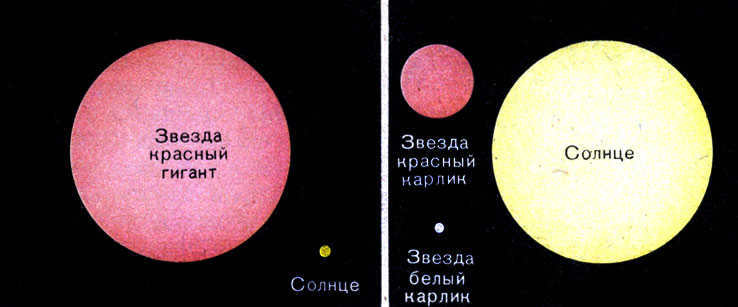
Let’s take a simple example to demonstrate how we can compare the sizes of stars with the same temperature, like the Sun and Capella. Despite having the same spectra, color, and temperature, Capella is 120 times more luminous than the Sun. Since the brightness of a unit of surface area is the same at the same temperature, it implies that the surface area of Capella is 120 times larger than that of the Sun. Consequently, the diameter and radius of Capella are approximately 11 times larger than those of the Sun, as the square root of 120 equals approximately 11. By understanding the laws of radiation, we can determine the sizes of other stars.
The findings of these calculations were fully validated when the possibility to measure the angular diameters of stars using an optical device, known as the stellar interferometer, arose. Stars with exceptionally high luminosity are referred to as supergiants. Red supergiants, in particular, are distinguished by their immense size. Betelgeuse and Antares, for instance, have diameters hundreds of times larger than that of the Sun. The more remote VV Cepheus is so colossal that it could encompass the entire Solar System, including the orbits of all the planets up to Jupiter. Despite this, the masses of supergiants are only 30-40 times greater than that of the Sun. Consequently, even the average density of supergiants is thousands of times lower than that of the air in a room. In stars, the hotter they are, the smaller their size at the same luminosity. Among regular stars, the smallest are known as red dwarfs. These stars have radii and masses that are a fraction of the Sun’s, and their average densities are 10-100 times higher than that of water. Another type of peculiar star is the diminutive red white dwarf. A well-known example is Sirius, which is nearby and luminous. Sirius has a companion star that orbits it every 50 years, and the distance, orbit, and masses of both stars are well-documented. Both stars are white and have similar high temperatures.

Gigantic stars speak for themselves and therefore possess a significantly larger radius and high luminosity in comparison to those stars in the main sequence that possess the same surface temperature. The radius of gigantic stars typically falls within the range of 10 to 100 times that of the sun, and they have luminosities ranging from 10 to 1000 times that of the sun. The temperature of gigantic stars is relatively low due to the mass of the star being distributed across the entire surface, and it reaches approximately 5000 degrees Celsius.
Nevertheless, there are also stars that have a much greater luminosity than gigantic stars. Such stars are commonly known as supergiants and hypergiants.
Because of their enormous masses, these stars have very short lifetimes, usually ranging from 30 to several hundred million years. Supergiants are typically found in areas of active star formation, such as scattered star clusters, spiral galaxy arms, and irregular galaxies.
Within the category of giant stars, there are red giants.
A red giant is a star with late spectral classes that possesses high luminosity and extended envelopes. Some well-known red giants include Arcturus, Aldebaran, Hakruks, and Mira.

Red giants have a relatively low temperature on their radiating surface, typically ranging from 3000 to 5000 degrees Kelvin. The size of red giants is much larger compared to the Sun, with a radius between 100 and 800 times that of the Sun.
As red giants evolve, they increase in size by a factor of 10-100, while their surface temperature decreases and they gradually release their outer gas layers into space.
Aside from red giants, there are also white giants. White giants are main-sequence stars that are hot and bright. Sometimes, a white giant can form a binary system with a red dwarf, resulting in a double or multiple star system composed of different types of stars.
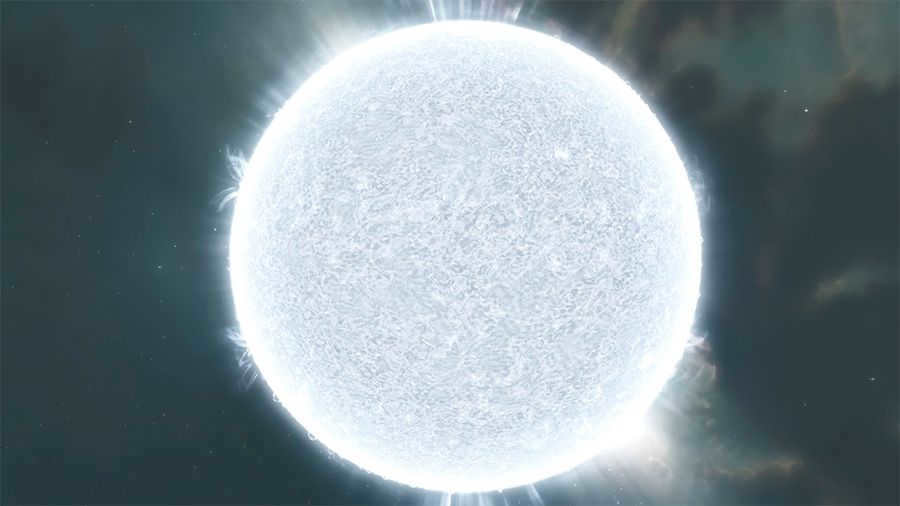
Supergiant stars are among the largest stars in the universe. Supergiant stars can have masses ranging from 10 to 70 times that of our sun, and their luminosities can range from 30,000 to hundreds of thousands of times that of our sun. The size of these stars can vary greatly, with radii ranging from 30 to 500 times that of our sun. In some cases, the radii can exceed 1000 times that of our sun, and these stars are then classified as hypergiants.
In the universe, there exist supergiants that come in two different colors: red and blue. Red supergiants, with their relatively cool surfaces, emit much less energy per unit area compared to their hot blue counterparts. As a result, a red supergiant will always have a larger size than a blue supergiant, given the same level of luminosity.
When large stars reach a certain stage in their life cycle, their cores start to burn carbon and oxygen, marking the moment when they transform into red supergiants. It is typically at this stage that red supergiants meet their end and undergo a cataclysmic supernova explosion. The explosion leads to the formation of a new nebula from the star’s gas envelope, while the degenerate core transforms into a white dwarf. Among the dying red stars, Antares and Betelgeuse stand out as the largest ones.
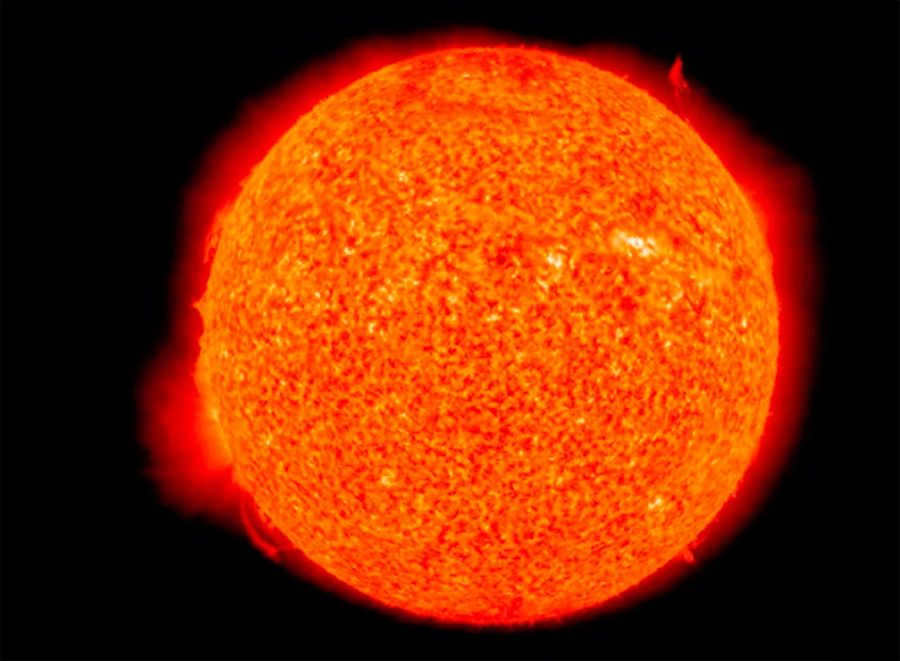
Blue giants, unlike red giants which are in the later stages of their life cycle, are young and incredibly hot stars that have a mass 10-50 times that of the Sun and a radius 20-25 times larger. These stars have an impressive temperature range of 20-50 thousand degrees. The surface of blue supergiants is rapidly contracting as a result of compression, which leads to an increase in internal energy emission and a rise in temperature. Rigel, the brightest star in the Orion constellation, serves as an excellent example of a blue supergiant. It has a massive mass that is 20 times greater than that of the Sun, and its luminosity is 130 thousand times higher.
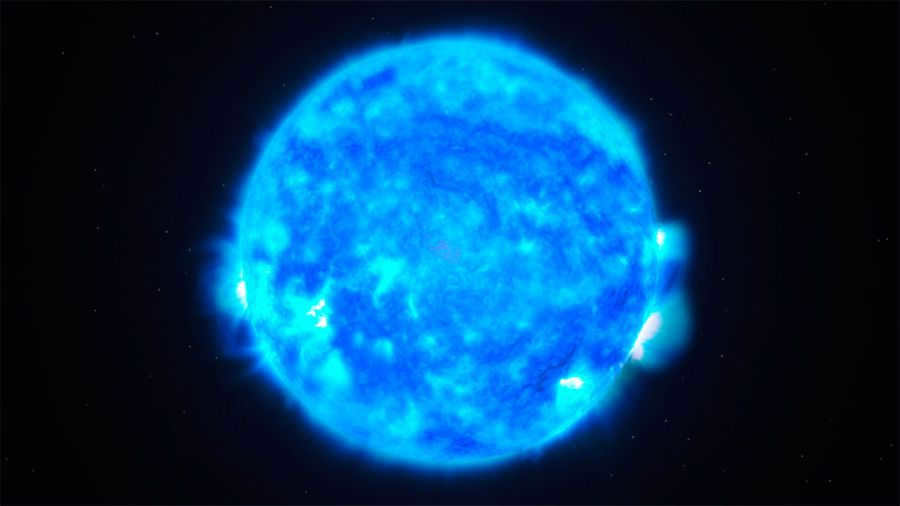
Hypergiants are slightly larger than supergiants in size, but they dominate in terms of mass by a factor of tens, and their brightness ranges from 500 thousand to 5 million times that of the Sun. These stars have relatively short lifespans, sometimes lasting hundreds of thousands of years. Our Galaxy has been found to contain approximately 10 of these exceptionally bright and powerful objects.
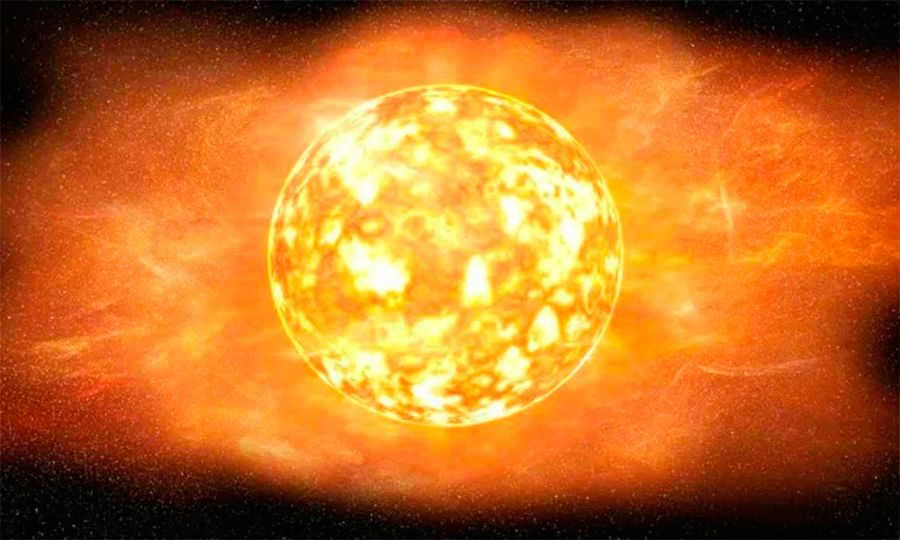
There is a hypergiant star located on the edges of the Westerlund 1-26 (W 26) cluster.
The most significant bodies in the Universe are known as stars because they comprise over 90% of all the matter we observe.
Each star is a massive gas ball that emits its own light, in contrast to planets that reflect sunlight. Stars share a similar nature with the Sun, which is the nearest star to Earth.
All stars are located far away from us, and the distance to each of them, excluding the Sun, is much greater than the distance from Earth to any of the planets in our solar system. One method of determining distances to relatively close stars involves measuring their apparent displacement against the more distant stars due to the Earth’s orbit around the Sun.
The nearest star to our Solar System, Proxima Centauri, is approximately 1.3 parsecs away. The majority of stars that are visible to the naked eye are located tens or hundreds of light-years from Earth.
Stars differ in terms of mass, size, density, luminosity, and chemical composition.
Now let’s delve deeper into these characteristics.
In order to determine the masses of stars, scientists study the movements of stars in pairs or groups. These stars attract one another and orbit around a common center of mass, known as double stars. The masses of stars can be determined using the law of universal gravitation. Typically, a star’s mass is measured in units relative to the mass of our Sun, which is approximately 2-10^30 kilograms. Most stars have masses ranging from 0.1 to 50 times that of the Sun.
The sizes of stars are determined through various methods, including direct measurements using optical interferometers and theoretical calculations. It has been discovered that the majority of observed stars have sizes ranging from hundreds of thousands to millions of kilometers. For instance, the Sun has a diameter of 1,392,000 kilometers. However, there also exist very small stars such as white dwarfs and tiny neutron stars, which have diameters of only 10-20 kilometers. On the other hand, there are giant stars, such as Betelgeuse, Arcturus, and Antares, which have sizes many times larger than the Sun. But the most colossal stars are the rare red supergiants, which are exceptionally large. If any of these stars were to replace the Sun, the orbit of Mars or even Jupiter would be contained within them!
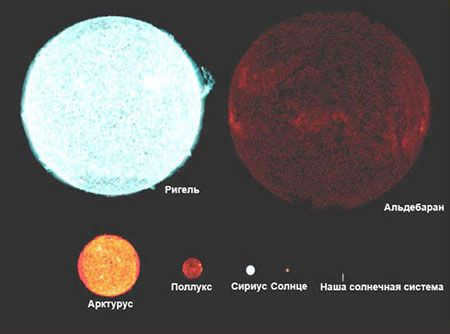
Comparison of star dimensions
Therefore, stars exhibit a greater variation in size than in mass. As a result, smaller stars tend to have higher matter density, while larger stars have lower matter density. In fact, the matter density of giant and supergiant stars can be lower than that of air under normal terrestrial conditions. The average density of solar matter is 1.4 times that of water. White dwarfs, on the other hand, have significantly higher density than the Sun. For example, 1 cm3 of substance from the star Sirius B has a mass of over 50 kg, and some white dwarfs are even tens of times denser. However, neutron stars surpass them all in density, with a density equivalent to that of atomic nuclei – 10^14 g/cm3. Achieving such a density would require compressing the entire globe to the size of half a kilometer!
The spectrum analysis is used to determine the chemical makeup of stars, which has revealed that they contain the same elements as found on Earth. Hydrogen and helium, the two lightest elements, make up over 98% of the mass in most stars, with hydrogen being approximately 2.7 times more massive than helium. The remaining 2% of the mass is composed of other elements.
Due to their opacity, the chemical composition of stars can only be directly observed in their surface layers, where light originates. However, through theoretical calculations, scientists are able to make predictions about the composition of various elements in the interior of stars.
Based on the physical characteristics of matter, all known stars can be categorized into three groups: regular stars, white dwarfs, and neutron stars.
Regular stars encompass the majority of observable stars, including those visible to the naked eye or through a small telescope. They consist of a gas that behaves normally in terms of its properties, known as an ideal gas. The pressure of this gas is directly proportional to its temperature and inversely proportional to the volume it occupies. By applying the physical laws that govern gas behavior, astronomers can determine the density, pressure, and temperature within stars, which is crucial for comprehending their structure and evolution.
In stars with extremely high densities, the behavior of matter no longer adheres to the principles of an ideal gas. Instead, it takes on different characteristics and is referred to as degenerate gas. Degenerate gas is found in white dwarfs and also in the cores of certain giant stars.
Neutron stars have an incredibly high density, so much so that atomic nuclei cannot even exist within them. The majority of the matter in neutron stars consists of electrically neutral elementary particles known as neutrons. In their normal state, neutrons, along with protons, make up atomic nuclei.
The gravitational force has an impact on the composition of any star, causing it to be compressed. Nevertheless, stars do not undergo rapid shrinkage due to the counteracting pressure force exerted by the stellar matter. In typical stars, this pressure arises from the elastic characteristics of a hot ideal gas. In the case of white dwarfs, compression is prevented by the pressure exerted by degenerate gas, which is nearly unaffected by the temperature. Neutron stars, on the other hand, experience restraint on gravity due to the nuclear forces that operate between individual neutrons.
Red giants, some stars, have such high temperatures in their central regions that a reaction between helium nuclei occurs, resulting in the creation of carbon, a heavier element. This reaction also releases energy.
According to current scientific theories, the majority of elements heavier than helium found in nature were formed through thermonuclear reactions within stars or as a result of reactions in supernova explosions.
When a star is very young and nuclear reactions have not yet begun, its energy source may be the compression of stellar matter, where the matter becomes more compact under its own gravity. In this scenario, the potential energy of the matter decreases and transforms into thermal energy.
A similar future awaits our Sun: in 6-7 billion years, after going through the red giant phase, it will transform into a white dwarf.
Rasner Vyacheslav Romanovich conducts guided tours called “Nevsky Prospekt: From Home to Home”. Save e.
On June 2, 2018, at 10:47, a person was hospitalized from the address Esenina St., 32, bldg. 2 (St. Petersburg, Vybo.
Can we lend a hand to the little cat? Urgently share this post! My friends, we all adore kittens, don’t we? They need help the most.
Assist liru-kotik! There are kittens in the pictures, there are kittens on the streets. There’s a small group of kittens that requires immediate attention.
Moscow Group for Finding Missing Children – Link to the orientation in vk Community “Search for Missing De.
–Connected Pages
–Keywords
–Tunes
–Sign up for updates
–Buddies
–Frequent visitors
–Groups
–Broadcasts
Typically, astronomers are focused on studying objects that are characterized by immense distances, sizes, and masses. They are constantly searching for the biggest star, the largest nebula, the most distant galaxy, the most massive black hole, the fastest pulsar, the brightest quasar, and so on. However, we often neglect to consider what exists on the opposite end of this “scale”.
Of course, we are not currently discussing the realm of the microcosm, such as leptons, baryons, quarks, and other quantum mechanical phenomena. Our focus remains on the field of astronomy.
However, have you ever wondered about the tiniest stars rather than the largest ones? What exactly constitutes the smallest star?
It is common knowledge that stars derive their energy from fusion reactions that occur in their cores, with hydrogen being the primary fuel for these reactions. To initiate a nuclear fusion reaction at the heart of a star, extremely high pressure and temperature must be attained. This requires the star to possess sufficient mass, allowing gravity to compress the hydrogen to the necessary pressure. Without enough mass, the reaction will fail to ignite, resulting in a starless entity resembling a gas giant planet like Jupiter. So, what is the mass threshold for a successful fusion reaction?
Let’s take a look at Proxima Centauri, the Sun’s closest neighbor. This red dwarf star, captured in a 1996 image by the Hubble Space Telescope, serves as an interesting example.
According to scientists, in order for a thermonuclear reaction to occur in the center of a star, the star must have a mass of at least 7.5% of the mass of the Sun. Interestingly, the Sun itself happens to have a mass equal to one solar mass (Drase). Therefore, a star with a mass of 7.5% of the Sun’s mass would be considered very small and would emit a low amount of light and heat. This type of star is known as a red dwarf and falls into the spectral class M. It has a surface temperature ranging from approximately 1500-1800°C, while the Sun’s surface temperature is 6000°C for comparison.
The naked eye can detect the smallest star known as 61 Swans, which has a diameter that is 66% of the Sun’s diameter. This star is situated just 11.4 light years away and can be faintly perceived.
Epsilon Eridana, the second largest star visible without a telescope or binoculars, is familiar to Star Trek fans as the home star of the Vulcans. It is an orange dwarf with a spectral class of K2 and its diameter is 85% of the Sun’s diameter. Epsilon Eridana is located at a distance of 10.5 light-years from our position.
The third position on this list is occupied by Alpha Centauri B, the second largest star in the Alpha Centauri triple system (with Alpha Centauri A being the largest and brightest component of the system). The third star, Proxima Centauri, is not visible to the naked eye. Alpha Centauri B has a diameter that is 87% of the Sun’s diameter and is located 4.36 light-years away from us. Interestingly, a planet has been discovered near Alpha Centauri B, making it the closest exoplanet to us at the moment. Unfortunately, the conditions for life on this planet are highly unlikely due to its proximity to the star. However, it is possible that there are other planets near Alpha Centauri B or the two other stars in this system. The reason for this is that planets that orbit close to a star are the easiest to detect, while those further away are more difficult to detect.
However, the fourth biggest celestial body that is observable without the aid of any instruments is… Can you guess what kind of celestial body it is?
That’s correct, it is our very own Sun. The only issue is that this celestial body can only be seen during the daytime and not at night. Mm-hmm. Wink wink.
Of course, some individuals may consider the star Tau Kita, which has a diameter that is 79% of the Sun’s and is situated 11.9 light years away. However, this celestial body is on the verge of being visible to the naked eye (stellar magnitude 5.69), and only individuals with exceptional visual acuity will be able to observe it.
Therefore, all of the other celestial bodies that we perceive when we gaze up at the starry sky are larger and more luminous than our Sun. There are numerous celestial bodies in the vicinity of our solar system, but only a small number of them can be seen without any instruments. You would need a telescope to observe the rest.
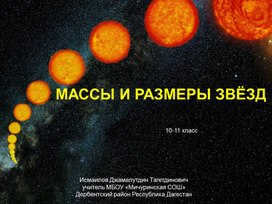
Differentiating between optical double stars and physical double stars among the stars visible side by side in the sky
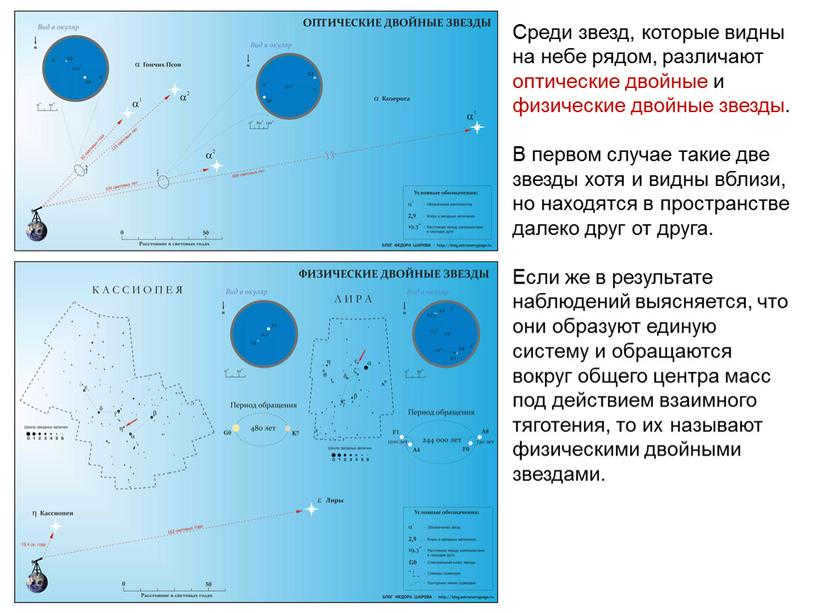
Optical double and physical double stars can be distinguished among the visible stars in the nearby sky.
In the first scenario, these two stars may appear close together in the sky, but they are actually far apart in terms of their spatial distance.
If observations reveal that they are part of a single system and orbit around a shared center of mass due to mutual gravitational forces, they are classified as physical double stars.
A renowned British astronomer was the first to provide evidence of the existence of physical binary stars.


V. J. Struve made numerous discoveries and conducted extensive studies on double stars.
Currently, there are over 70,000 known double stars.
Vasily Yakovlevich (Friedrich Georg Wilhelm) Struve (1793-1864) was a renowned astronomer who served as a member of the St. Petersburg Academy of Sciences, the inaugural director of the Pulkovo Observatory, and a founding member of the Russian Geographical Society.
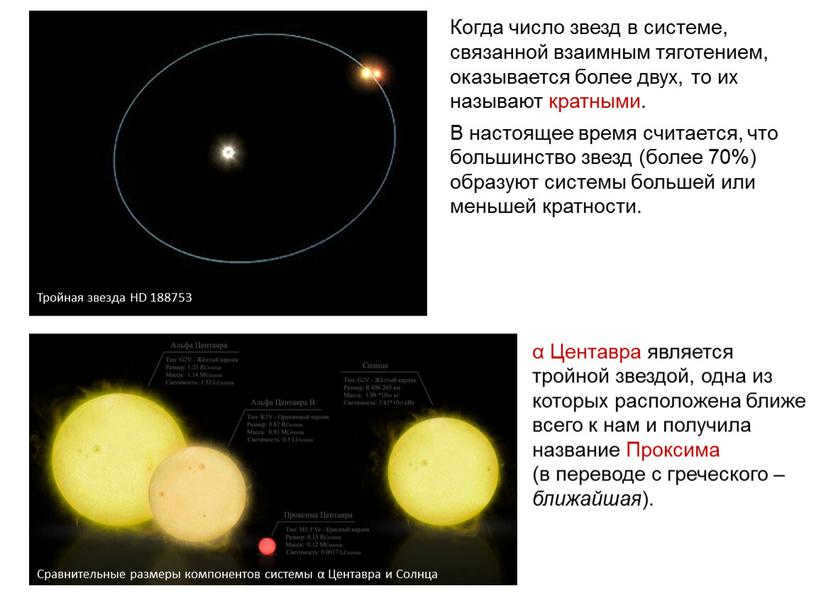
α Centauri is a triple star system, with the closest star to us being named Proxima. It is the nearest star to us.
Castor is a multiple star system composed of six individual stars.
Comparing the sizes of the components in the α Centauri system to the Sun.
When a system has more than two stars bound together by mutual gravitation, they are referred to as multiple star systems.
It is currently believed that the majority of stars (over 70%) form systems with varying degrees of multiplicity.
This is a unique occurrence of a binary star system where both stars can be seen separately without the aid of a telescope
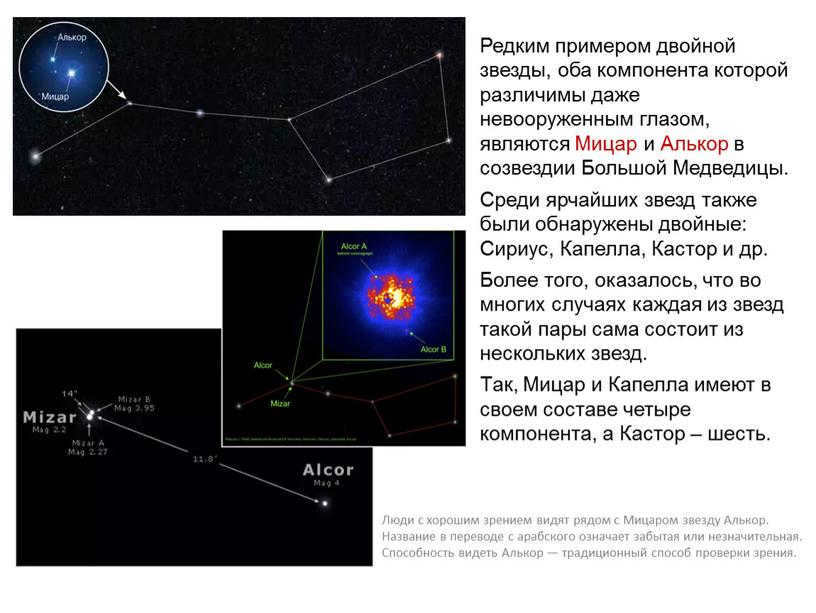
Mizar and Alcor in the constellation of the Big Dipper are a unique double star that can be seen with the naked eye. It is rare to find a double star where both components are distinguishable without the aid of a telescope. Additionally, there are other bright double stars such as Sirius, Capella, and Castor that have been discovered. Interestingly, it has been found that many of these double stars are actually comprised of multiple stars themselves. For example, Mizar and Capella have four components each, while Castor has six.
Those with good eyesight can also see the star Alcor next to Mizar. In Arabic, Alcor means forgotten or insignificant. It has become a traditional way to test one’s eyesight by being able to spot Alcor alongside Mizar.
Vesta Castor – the constellation’s second most luminous star
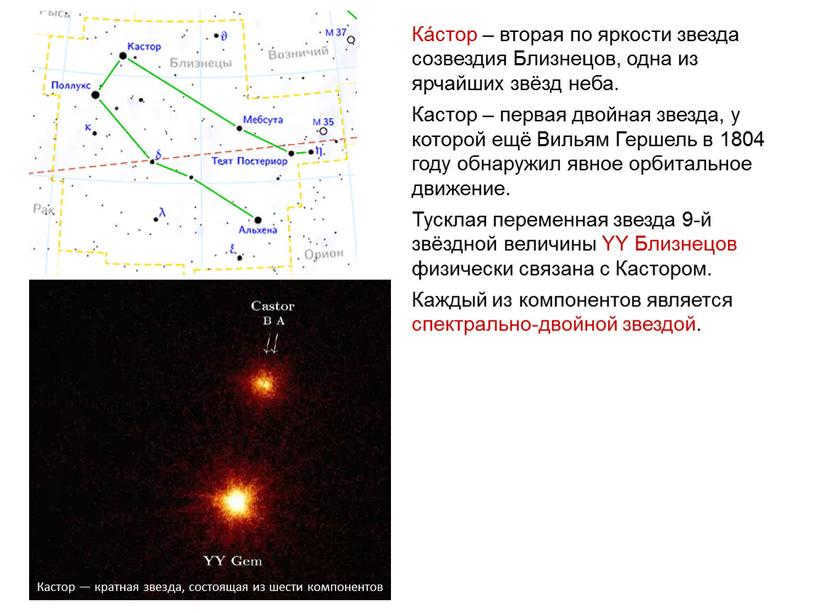
Castor, located in the constellation Gemini, is the second brightest star in the constellation and one of the most prominent stars in the night sky.
Discovered by William Herschel in 1804, Castor is the first double star to exhibit clear orbital motion.
YY Gemini, a dim variable star with a magnitude of 9, is physically associated with Castor.
Both components of Castor are also double stars in terms of their spectral properties.
Castor is a multiple star system consisting of six individual components.
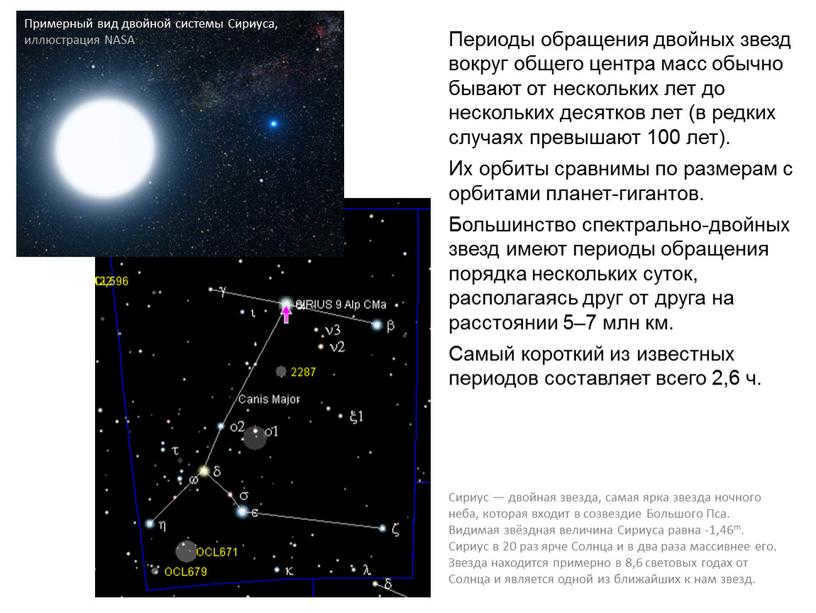
The orbital periods of binary stars, which revolve around a common center of mass, typically range from a few years to several decades (rarely exceeding 100 years).
These binary systems have orbits that are similar in size to those of massive planets.
Most binary stars with spectral classification have orbital periods of a few days and are located about 5-7 million kilometers apart.
The shortest known orbital period for a binary star system is a mere 2.6 hours.
Sirius, a famous double star, holds the title for being the brightest star in the night sky and is a prominent member of the Canis Major constellation.
With an apparent magnitude of -1.46m, Sirius shines with a luminosity 20 times greater than that of the Sun and possesses twice the mass of our own star.
This binary system is approximately 8.6 light-years away from the Sun, making it one of the closest stellar neighbors to our Solar System.
Although there is a significant amount of binary stars, the orbital paths of only approximately one hundred of them have been accurately ascertained.
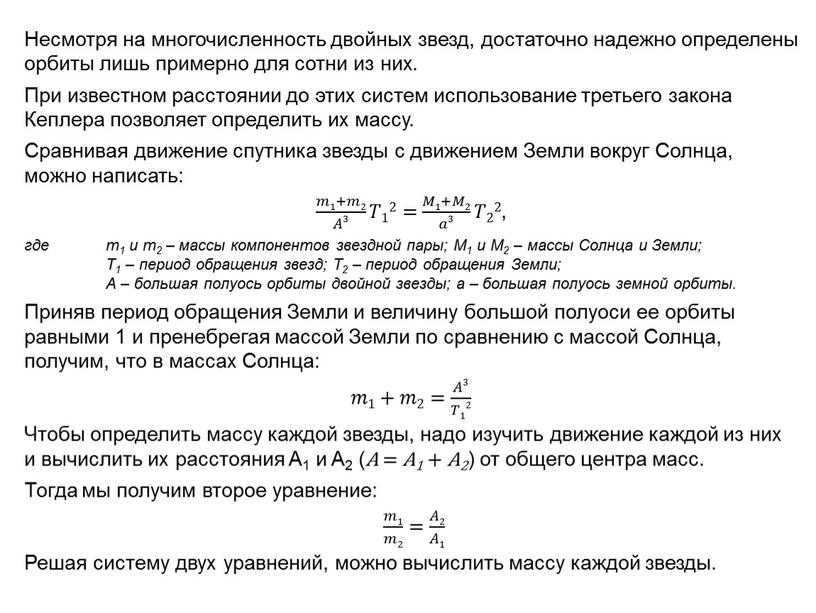
Spectrally binary stars exhibit a spectral line shift (or bifurcation), resulting from the phenomenon of spectral displacement (or bifurcation).
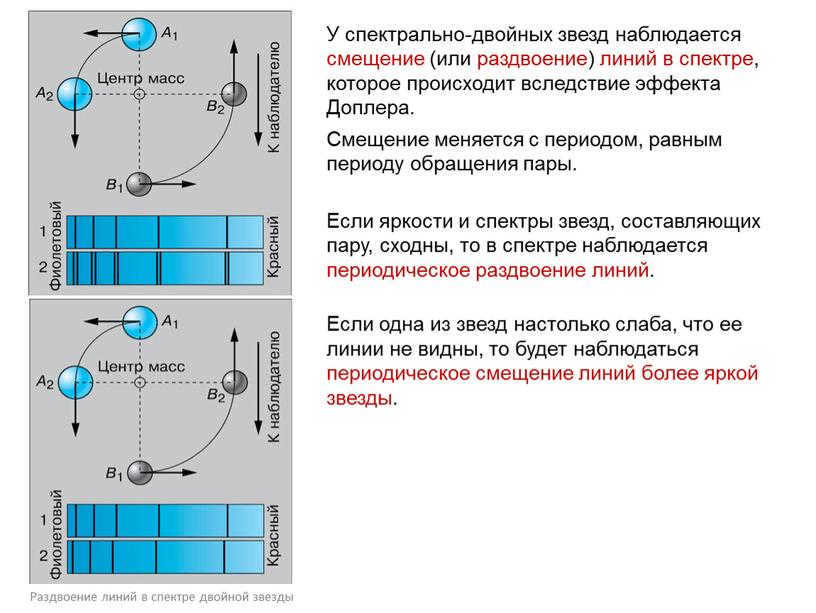

Spectrally double stars exhibit a phenomenon called line bifurcation in their spectrum, which is caused by the Doppler effect. The shift of the lines in the spectrum changes periodically in sync with the rotation period of the star pair.
If the stars in the pair have similar brightness and spectra, a recurring pattern of line bifurcation can be observed in the spectrum.
In cases where one of the stars is too dim to have visible lines, there will still be a periodic shift in the lines of the brighter star.
Line bifurcation can be observed in the spectrum of a double star.
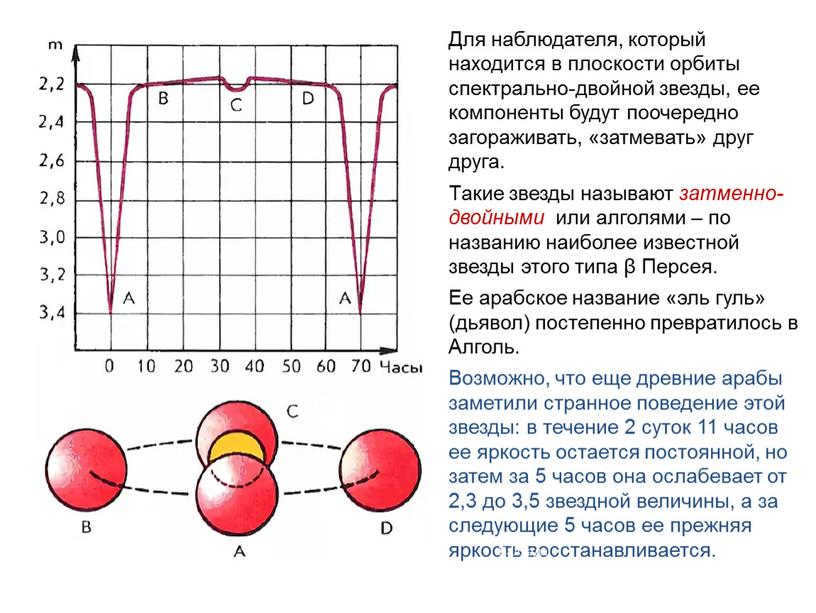
If an observer is situated in the orbital plane of a binary star system with distinct spectra, the two components will alternatively obscure each other, resulting in what is known as an eclipse. These types of stars are referred to as eclipsing binaries or Algol stars, after the most well-known example, β Perseus. The star’s Arabic name, “el gul” (the devil), gradually evolved into Algol. It is possible that even ancient Arab astronomers noticed the peculiar behavior of this star: for a period of 2 days and 11 hours, its brightness remains constant, but then weakens from a stellar magnitude of 2.3 to 3.5 for 5 hours, before returning to its original brightness for the next 5 hours.
There are currently over 5,000 known eclipsing double stars
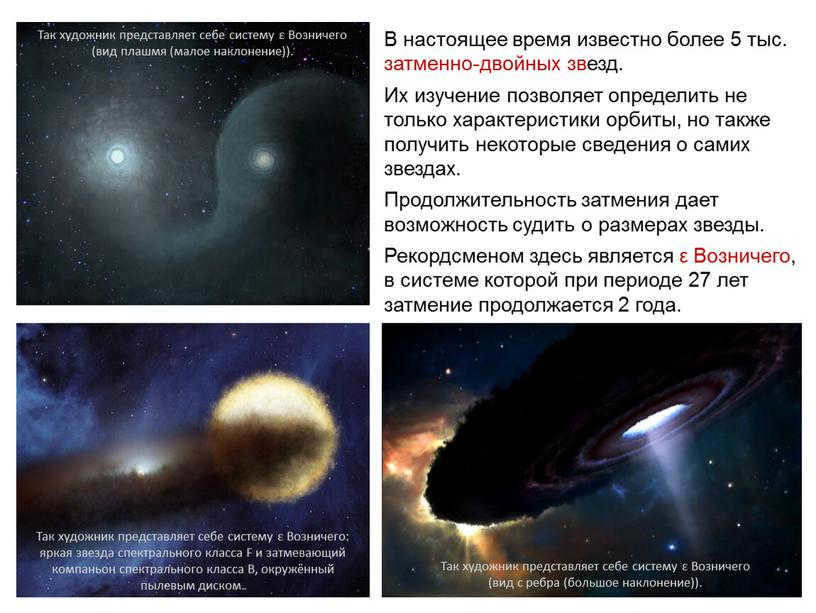

Currently, there are over 5 thousand binary stars that exhibit eclipses.
Studying these stars not only helps us understand their orbital characteristics, but also provides insights into the stars themselves.
By observing the duration of the eclipses, we can estimate the size of the stars.
One particularly remarkable example is the ε Ascendant system, where the eclipse lasts 2 years within a 27-year period.
This illustration depicts the ε Ascendant system from a flattened perspective (with low inclination).
The artist’s rendition of the ε Ascendant system shows a bright star of spectral class F and an eclipsing companion of spectral class B, surrounded by a disk of dust.
This is the artist’s interpretation of the ε Ascendant system
(as seen from a high inclination viewpoint).
The light curve of certain stars suggests that their shape deviates significantly from a spherical one
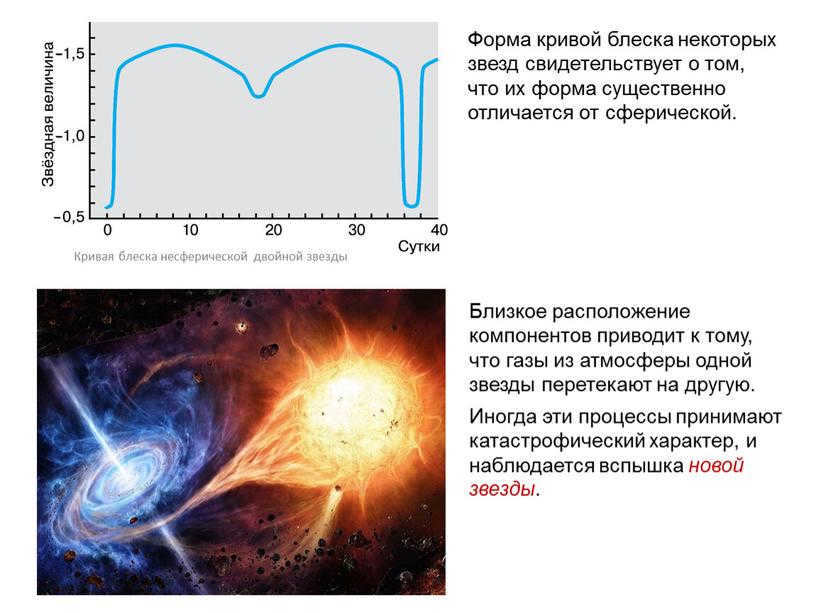
The light curve of certain stars suggests that they have a non-spherical shape.
Observing the light curve of a binary star system with a non-spherical shape
The close proximity of the stars leads to the transfer of gases from one star’s atmosphere to the other.
Occasionally, these processes can be catastrophic, resulting in the formation of a new star.
Studies of binary stars have provided valuable insights into the determination of stellar masses, revealing a wide range of values from 0.03 to 60 times the mass of our Sun.
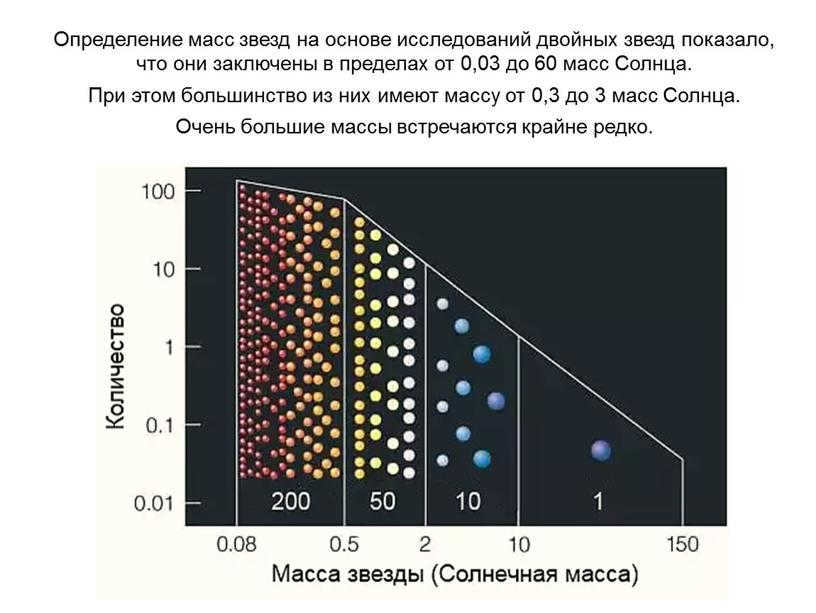

When studying binary stars, scientists have determined that their masses fall within the range of 0.03 to 60 solar masses.
However, the majority of these stars have masses between 0.3 and 3 solar masses.
Stars with very large masses are extremely uncommon.
Nowadays, the techniques employed to investigate the characteristics of double and eclipsing variable stars are also being utilized to detect exoplanets orbiting distant stars.
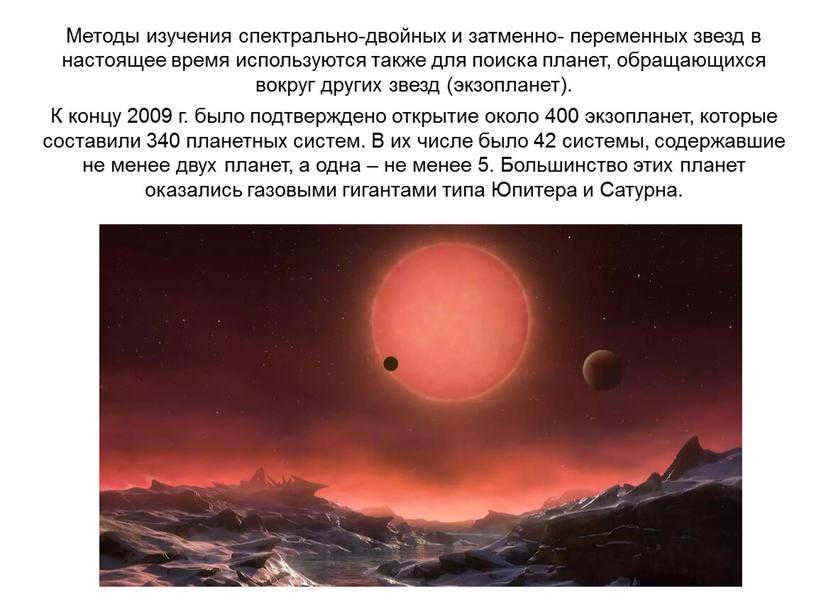
The techniques utilized in the study of spectrally double and eclipsing variable stars are currently being applied to the exploration of exoplanets, or planets orbiting other stars.
As of the conclusion of 2009, the confirmation of approximately 400 exoplanets had been achieved, comprising 340 distinct planetary systems. Among these systems, 42 were found to possess a minimum of two planets, with one system boasting a minimum of 5 planets. The majority of these planets were discovered to be gas giants, comparable in size to Jupiter and Saturn.
Scientists are focusing on discovering planets that have comparable size and mass to the ones they are searching for
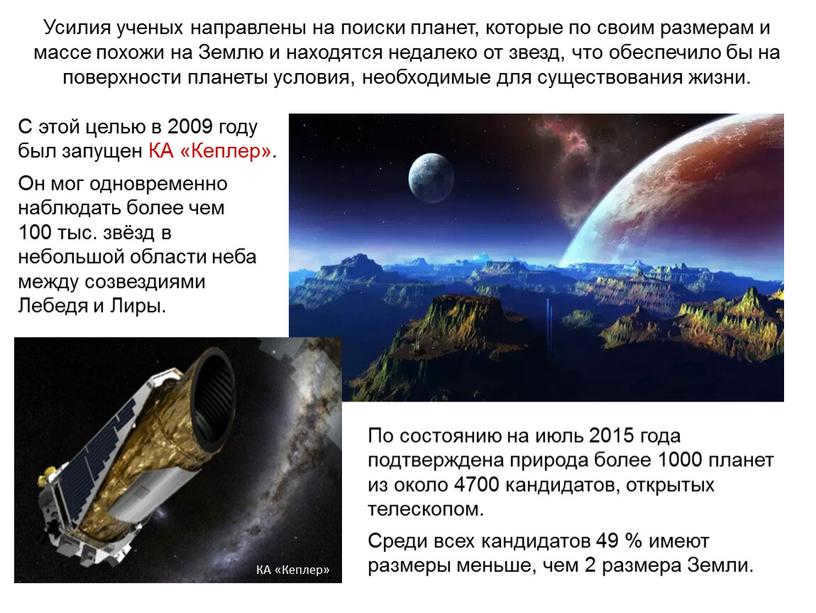

Scientists are dedicated to locating planets that are similar in size and mass to Earth and are in close proximity to stars that can provide the necessary conditions for life to exist on their surfaces.
In pursuit of this goal, the Kepler spacecraft was launched in 2009.
It had the ability to simultaneously observe over 100,000 stars within a small section of the sky located between the constellations of Cygnus and Lyra.
As of July 2015, the telescope has confirmed the existence of over 1,000 planets out of approximately 4,700 potential candidates.
Among all the candidates, 49% have a size smaller than that of Earth.

The size of stars and the density of their matter is a fascinating topic.
Stars are located at such a vast distance from us that, except for a few rare cases, they appear as mere dots even when observed through the most advanced telescopes.
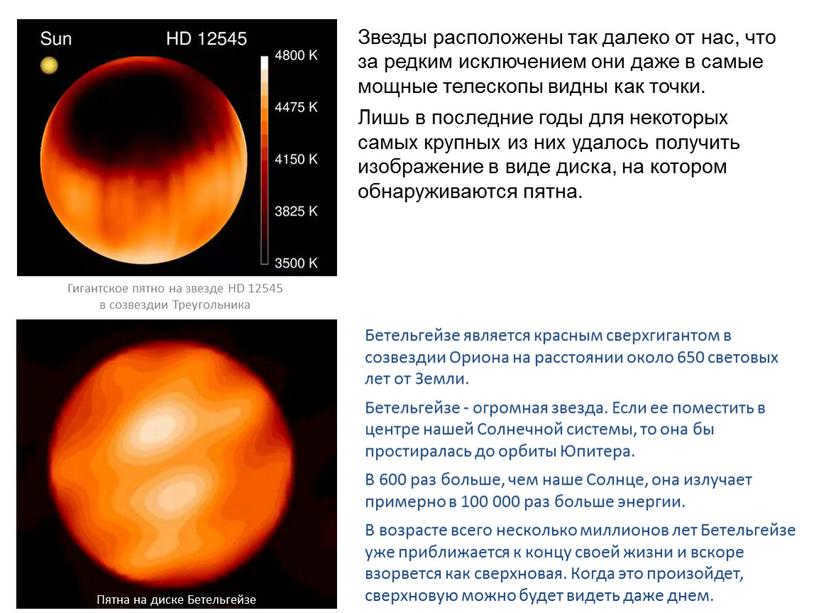

Stars are positioned at such vast distances from us that, with a few rare cases, they are observable as mere dots of light even when viewed through the most impressive telescopes.
Only in recent times have astronomers managed to capture images of some of the largest stars, revealing them as circular objects with visible spots.
Betelgeuse, located in the Orion constellation, is a red supergiant that is approximately 650 light-years away from Earth. This massive star is so enormous that if it were placed at the center of our solar system, it would extend all the way to the orbit of Jupiter. Comparatively, it is about 600 times larger than our Sun and emits approximately 100,000 times more energy. Despite being relatively young, at only a few million years old, Betelgeuse is already approaching the end of its life cycle and is expected to explode as a supernova in the near future. When this happens, the resulting supernova will be visible even during daylight hours.
In addition to Betelgeuse, there is a notable giant spot on another star known as HD 12545, which is located in the Triangle constellation.
Calculating the size of stars is typically done by determining their luminosity and temperature.
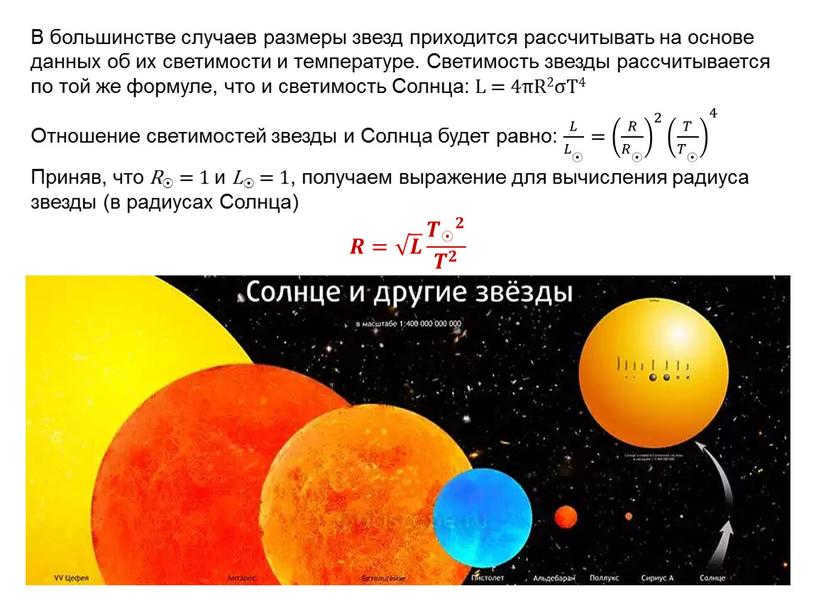
To calculate the size of stars, it is often necessary to use their luminosity and temperature. The luminosity of a star can be determined using the same formula as the Sun: L = 4πR2σT4
The ratio of the star’s luminosity to that of the Sun can be represented as: 𝐿 𝐿 . ���� �� �� �� ���� �� �� �� �� = �� �� 2 �� �� 4 �� �� 2 �� �� �� �� ���� �� �� �� ���� �� �� �� �� �� �� �� �� 2 2 �� �� 2 �� �� �� �� ���� �� �� �� ���� �� �� �� �� �� �� �� �� 2 �� �� 4 4 �� �� 2 �� �� 4
If we assume that R = 1 and L = 1, we can derive an expression for calculating the radius of the star (in terms of solar radii)
��= �� �� �� �� ��
The supergiants, which are the stars with the highest luminosity, have been discovered to possess an incredibly vast size
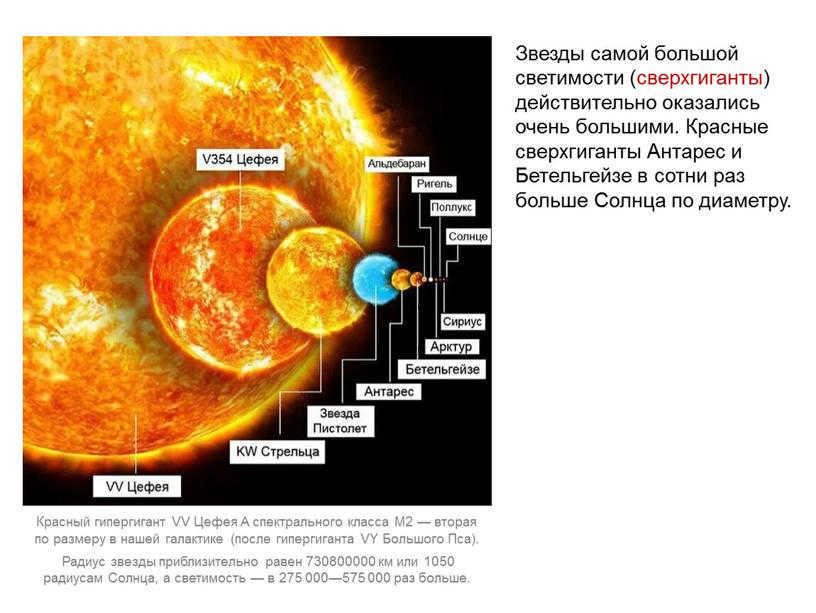

The supergiants, which have the highest luminosity, have indeed been revealed to be very large. The red supergiants Antares and Betelgeuse have diameters hundreds of times bigger than the Sun.
The red hypergiant VV Cepheus A, which belongs to spectral class M2, is the second largest star in our galaxy (after the hypergiant VY Canis Majoris).
The star has a radius of approximately 730,800,000 km or 1,050 solar radii and a luminosity 275,000-575,000 times greater.
The size of main-sequence red dwarfs is significantly smaller than the Sun
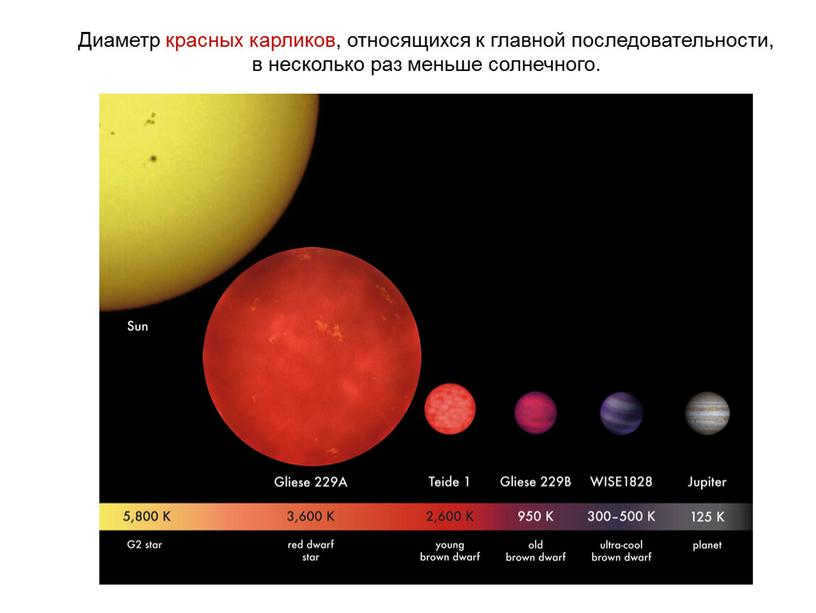

The smallest stars in the universe, known as main-sequence red dwarfs, have a diameter that is several times smaller than the diameter of the sun.
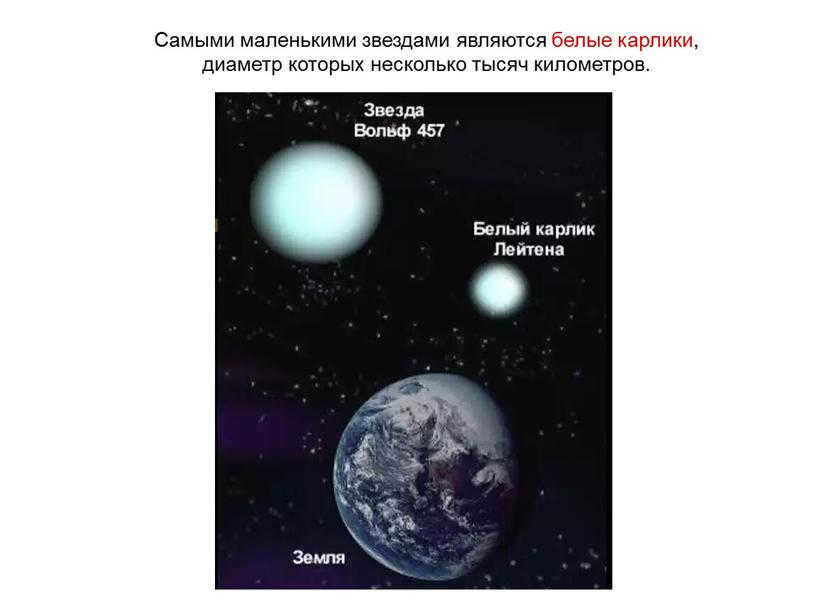
White dwarfs, which have a diameter of several thousand kilometers, are the smallest stars.
By using available data on the mass and size of various types of stars, calculations reveal that their average density can vary greatly from that of the Sun.
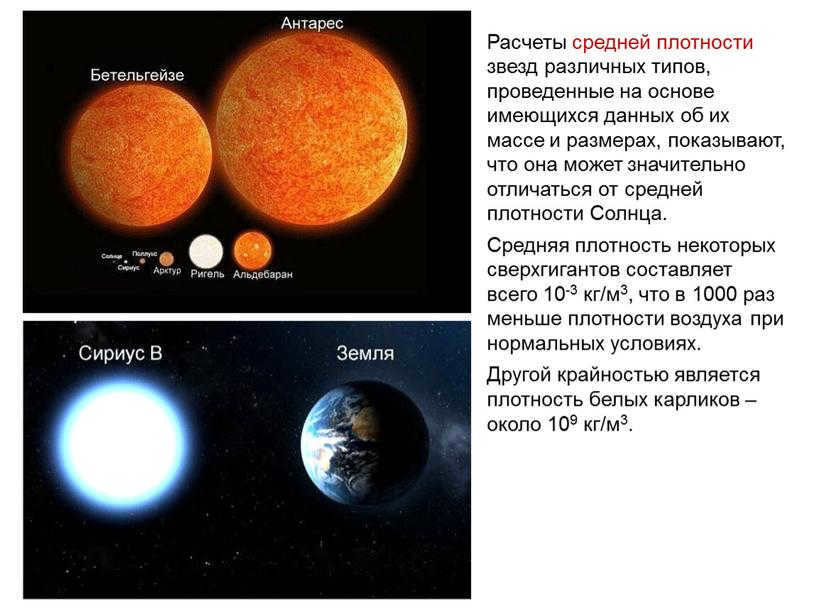
Calculations based on the available data on the mass and size of stars of different types indicate that their average density can vary significantly from the average density of the Sun.
For instance, some supergiants have an average density as low as 10-3 kg/m3, which is 1000 times less than the density of air under normal conditions.
On the other hand, white dwarfs have densities of about 109 kg/m3.
Types of Stellar Models

Stars differ in their internal structure depending on their mass and size, but they all share a similar chemical composition (hydrogen and helium make up about 95-98% of their mass).
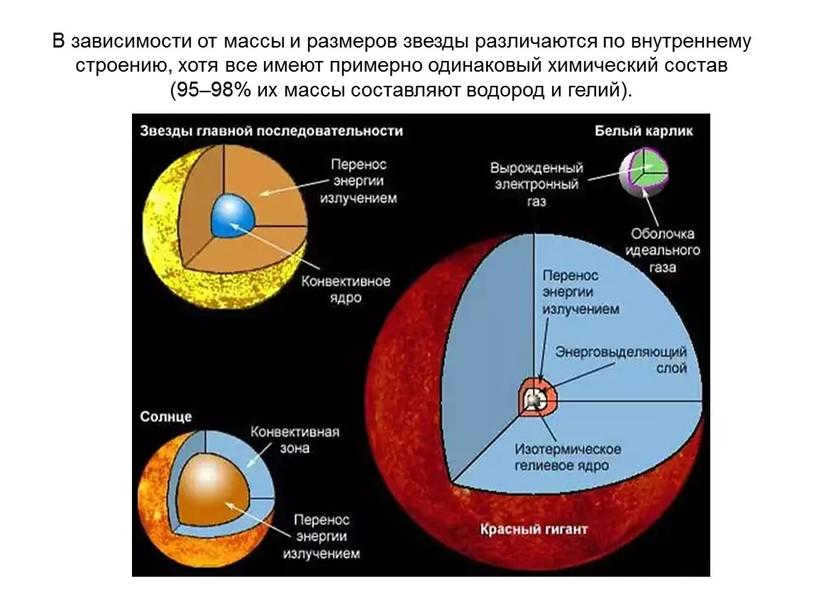

Stars have different internal structures depending on their mass and size, but they all share a similar chemical composition (hydrogen and helium make up 95-98% of their mass).
Main-sequence stars with an equivalent temperature to that of the main sequence stars.
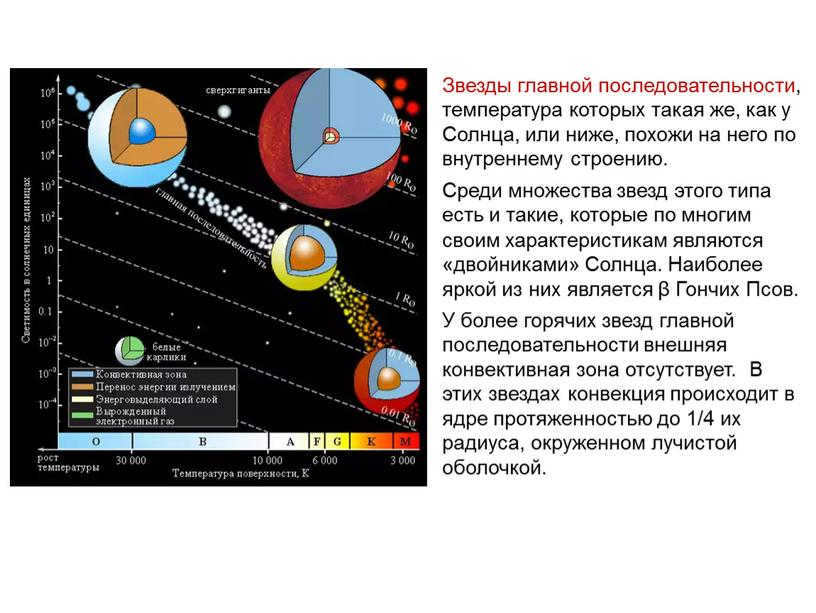
Main-sequence stars that have a temperature equal to or lower than that of the Sun have a similar internal structure.
Among the numerous stars of this kind, there are a few that resemble the Sun in various aspects. The most luminous of these is β of the Hound Dogs.
The hotter main-sequence stars lack an outer convective zone. In these stars, convection takes place in a core that extends up to 1/4 of their radius, surrounded by a radiative envelope.
Giants and supergiants possess an exceedingly minuscule core, with a radius that is approximately 0.001 fraction of the star’s overall radius
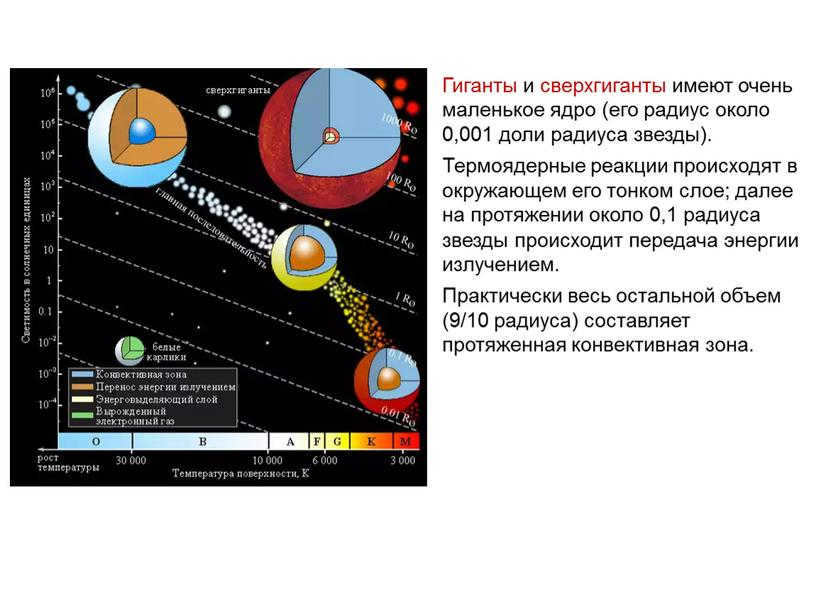

Giants and supergiants possess a minuscule core, with a radius that is roughly 0.001 fraction of the star’s radius.
Within the thin layer surrounding it, thermonuclear reactions occur, while energy transfer through radiation takes place for approximately 0.1 of the star’s radius.
The vast majority of the remaining volume (9/10 of the radius) consists of an expansive convective zone.
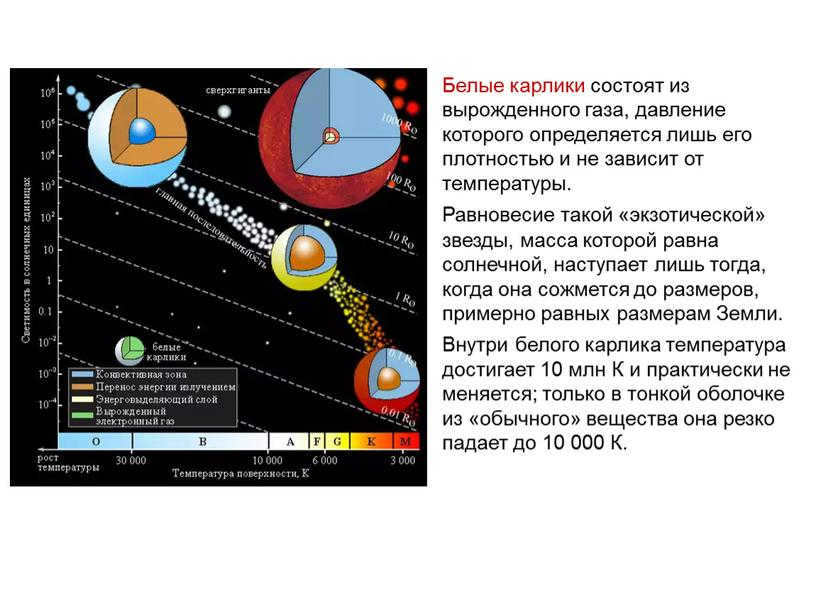
White dwarfs are composed of a dense gas that is governed solely by its density and is not influenced by temperature.
These “exotic” stars, with a mass equal to that of the Sun, only reach equilibrium when they contract to a size approximately equal to Earth.
Within a white dwarf, the temperature reaches a staggering 10 million K and remains relatively stable; only in a thin layer of “normal” matter does it decrease sharply to 10,000 K.
Brown dwarfs lack the sufficient mass required for the thermonuclear reaction that converts hydrogen into helium to occur
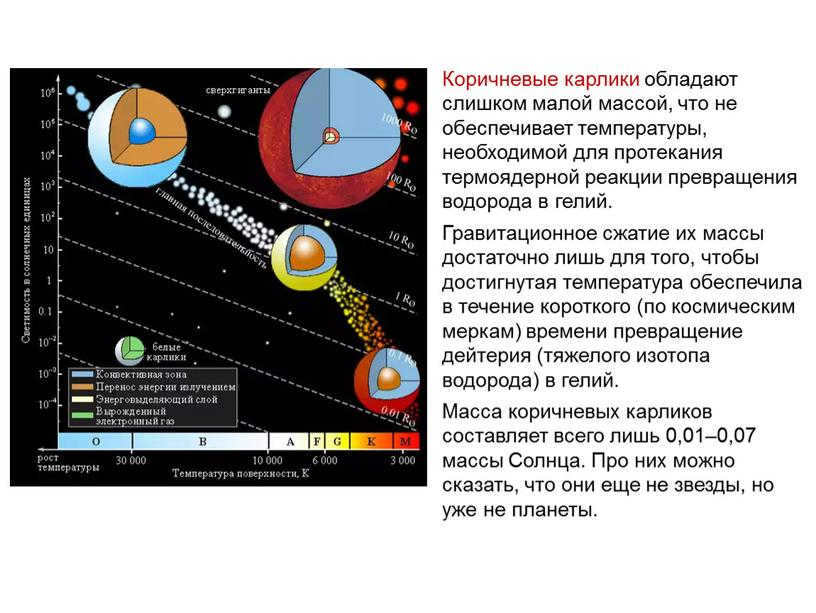
Brown dwarfs have insufficient mass to generate the required temperature for a thermonuclear reaction that would convert hydrogen into helium.
The gravitational compression of their mass only allows for temperatures that are adequate to facilitate the conversion of deuterium (a heavy isotope of hydrogen) into helium over a relatively short period of time, by cosmic standards.
The mass of brown dwarfs is only 0.01-0.07 times that of the Sun. It can be said that they are not yet stars, but they are also not planets.

What is the reason for the variation in luminosity among certain binary stars?
How much do supergiant and dwarf stars differ in terms of size and density?
What is the magnitude of the smallest stars?
Assignment 1) Section 23 2) Exercise 19 (p.163).


